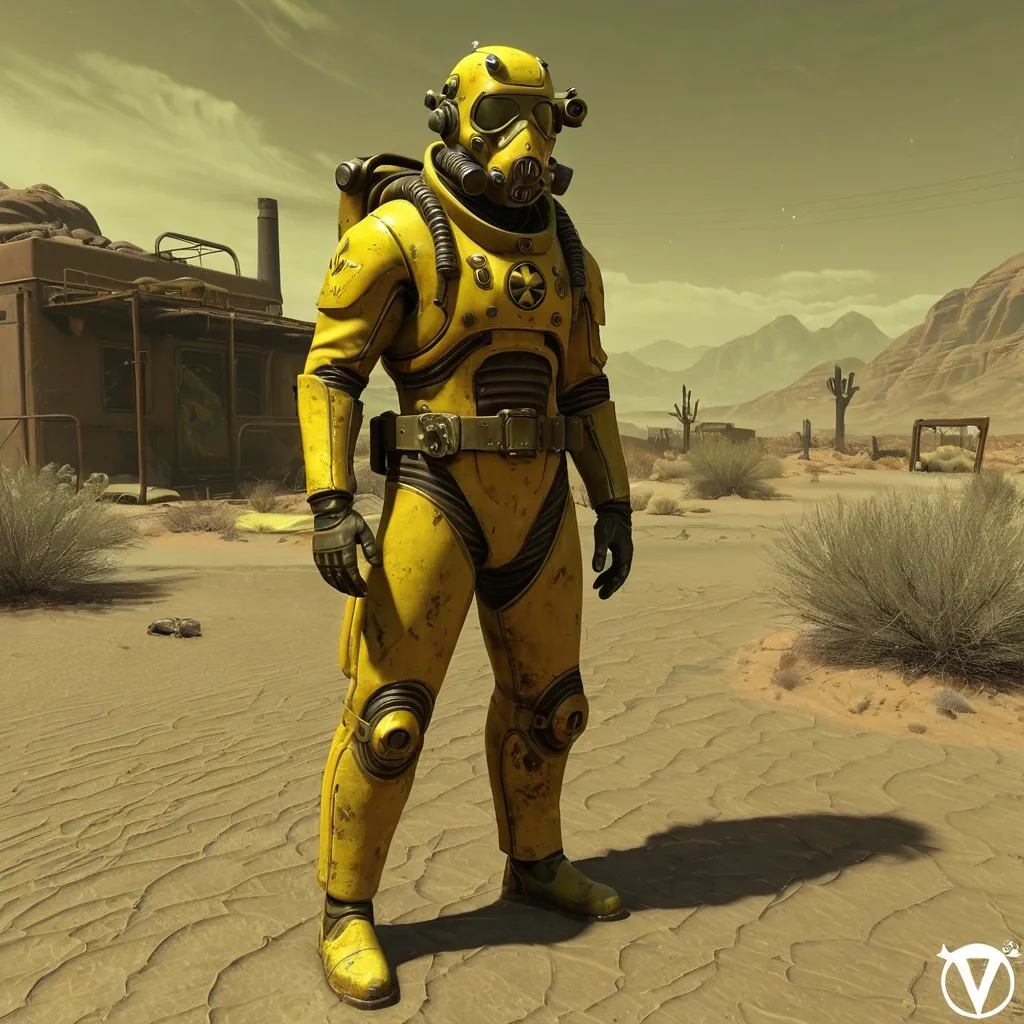Search Results for (radiation)
Explore AI generated designs, images, art and prompts by top community artists and designers.

A close-up shot of a Chernobyl liquidator's gas mask , filling the frame with gritty , realistic detail. The mask is worn and authentic , modeled after Soviet-era designs with rounded lenses , thick rubber seals , and heavy straps , covered in ash and grime from the reactor’s fallout. The lenses are the focal point , each glass surface slightly warped and scratched , reflecting the fierce glow of distant fires within the reactor. Flames dance across the curved lenses in shades of red , orange , and intense yellow , creating a haunting , distorted view of the fiery chaos within. Lighting and Shadow Play: The overall lighting is low and moody , with harsh shadows defining the rugged texture of the mask and highlighting its worn , weathered surface. Dim light from a flickering source to the left illuminates the mask partially , casting deep shadows across the rubber surface , creating an ominous , high-contrast look. Hazy backlighting subtly outlines the mask’s contours , adding depth and a sense of foreboding. Atmospheric Details: The air is thick with smoke and radioactive dust , faintly illuminated by the fiery reflection in the lenses. Tiny , glowing particles float through the air , adding to the toxic , dangerous atmosphere. Thin wisps of smoke drift around the mask , softening the edges and giving the scene a ghostly quality. Surface Texture and Wear: The rubber of the mask is cracked and stained , showing the toll of exposure to radiation and extreme heat. Ash and small flecks of debris cling to its surface , adding realism and a gritty feel. Around the edges , faint condensation gathers on the rubber , hinting at the liquidator’s breath inside the suit. Reflection Details in the Lenses: In the mask's lenses , we see reflections of distant fires raging inside the reactor , with structures burning and twisted metal faintly visible in the intense glow. The reflections are slightly distorted , warped by the rounded glass , as if the fires themselves are bending reality. Occasional flickers of light pulse in the reflection , conveying the flickering intensity of the flames. Mood and Composition: The close-up shot emphasizes the isolation , courage , and silent determination of the liquidator. The composition is hauntingly intimate , placing the viewer face-to-face with the mask , capturing the intensity of the task and the immense , invisible danger surrounding them. Every detail contributes to a heavy , foreboding atmosphere , evoking a sense of dread and silent resilience. ,
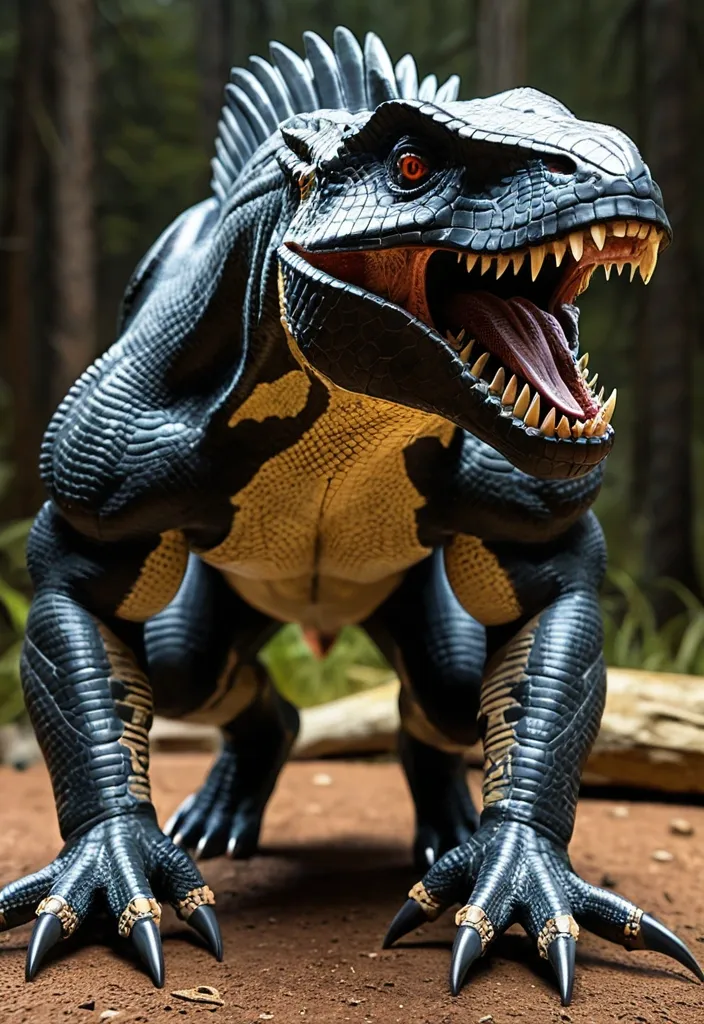
Physical Characteristics: Size & Build: Towering at around 15 feet tall and 40 feet long , Venenosus Rex exhibits a robust , muscular build with bulky , reduced hind legs adapted for powerful knuckle-walking quadrupedal locomotion , inherited from its Ape DNA. Its stance is low and intimidating , allowing swift bursts of speed and stability. Head: The head is a terrifying blend of Tyrannosaurus rex , Giganotosaurus , and Triceratops shapes—a broad , armored skull with a reinforced bony frill and horn-like protrusions from Triceratops , providing natural defense. Its jaw can open up to 90 degrees , snake-like , capable of delivering crushing bites able to shatter bulletproof glass. Skin & Camouflage: Covered in thick , overlapping Scelidosaurus-like osteoderm armor plates along the back and flanks , providing excellent protection against attacks. The skin contains chromatophore cells from cuttlefish DNA , allowing Venenosus Rex to dynamically change skin color , texture , and pattern for camouflage or intimidation. Arms & Claws: Long , powerful arms inspired by Saurophaganax and Ape DNA end in razor-sharp , hooked claws capable of slashing through armored prey and wielding tools for complex hunting strategies. Teeth & Fangs: Teeth are a deadly combination from the Inland Taipan’s retractable fangs , Komodo Dragon’s serrated teeth , and Northern short-tailed shrew’s sharp incisors , allowing it to pierce armor and inject highly toxic saliva into prey. Eyes & Senses: Equipped with specialized cranial cavities housing infrared vision , enabling night hunting and detection of body heat signatures. Its olfactory and auditory senses are exceptionally refined due to Utahraptor and Komodo Dragon ancestry. Unique Abilities: Extreme Environmental Resistance: Thanks to Tardigrade , Opossum , and Mongoose DNA , Venenosus Rex can survive extreme temperatures , radiation , dehydration , starvation , and bacterial infections. Its organs are shielded by trehalose gel , and its DNA is protected by specialized proteins against radiation damage. It can slow its metabolism down to 0.01% of normal , entering a near-hibernative state during harsh conditions. Toxic Saliva & Venom: Its saliva contains potent neurotoxins and anticoagulants , ensuring even minor bites are deadly over time. Combined with its retractable fangs , it can efficiently incapacitate prey or rivals. Camouflage & Stealth: Dynamic skin color and texture changes allow it to blend seamlessly into diverse environments or mimic threatening patterns to intimidate. Intelligence & Pack Hunting: Enhanced Utahraptor DNA grants high cognitive abilities , including planning , problem-solving , and social pack hunting tactics , making it a highly strategic predator. Tool Use: The combination of long , dexterous arms and ape DNA allows it to manipulate objects , set traps , or use environmental tools during hunts. Wide Jaw Opening: The ability to open its jaw at a 90-degree angle allows for impressive bite range and prey handling , intimidating foes with sudden wide gapes. ,
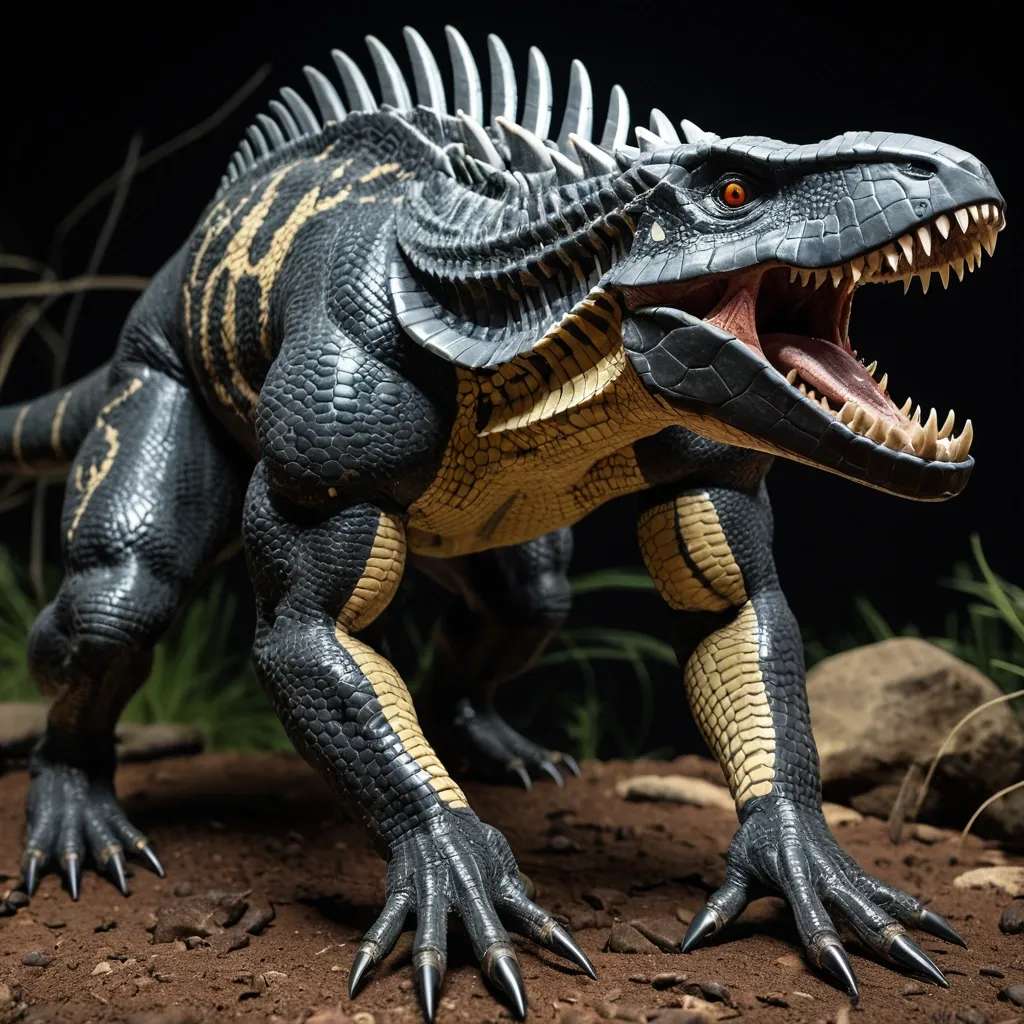
Physical Characteristics: Size & Build: Towering at around 15 feet tall and 40 feet long , Venenosus Rex exhibits a robust , muscular build with bulky , reduced hind legs adapted for powerful knuckle-walking quadrupedal locomotion , inherited from its Ape DNA. Its stance is low and intimidating , allowing swift bursts of speed and stability. Head: The head is a terrifying blend of Tyrannosaurus rex , Giganotosaurus , and Triceratops shapes—a broad , armored skull with a reinforced bony frill and horn-like protrusions from Triceratops , providing natural defense. Its jaw can open up to 90 degrees , snake-like , capable of delivering crushing bites able to shatter bulletproof glass. Skin & Camouflage: Covered in thick , overlapping Scelidosaurus-like osteoderm armor plates along the back and flanks , providing excellent protection against attacks. The skin contains chromatophore cells from cuttlefish DNA , allowing Venenosus Rex to dynamically change skin color , texture , and pattern for camouflage or intimidation. Arms & Claws: Long , powerful arms inspired by Saurophaganax and Ape DNA end in razor-sharp , hooked claws capable of slashing through armored prey and wielding tools for complex hunting strategies. Teeth & Fangs: Teeth are a deadly combination from the Inland Taipan’s retractable fangs , Komodo Dragon’s serrated teeth , and Northern short-tailed shrew’s sharp incisors , allowing it to pierce armor and inject highly toxic saliva into prey. Eyes & Senses: Equipped with specialized cranial cavities housing infrared vision , enabling night hunting and detection of body heat signatures. Its olfactory and auditory senses are exceptionally refined due to Utahraptor and Komodo Dragon ancestry. Unique Abilities: Extreme Environmental Resistance: Thanks to Tardigrade , Opossum , and Mongoose DNA , Venenosus Rex can survive extreme temperatures , radiation , dehydration , starvation , and bacterial infections. Its organs are shielded by trehalose gel , and its DNA is protected by specialized proteins against radiation damage. It can slow its metabolism down to 0.01% of normal , entering a near-hibernative state during harsh conditions. Toxic Saliva & Venom: Its saliva contains potent neurotoxins and anticoagulants , ensuring even minor bites are deadly over time. Combined with its retractable fangs , it can efficiently incapacitate prey or rivals. Camouflage & Stealth: Dynamic skin color and texture changes allow it to blend seamlessly into diverse environments or mimic threatening patterns to intimidate. Intelligence & Pack Hunting: Enhanced Utahraptor DNA grants high cognitive abilities , including planning , problem-solving , and social pack hunting tactics , making it a highly strategic predator. Tool Use: The combination of long , dexterous arms and ape DNA allows it to manipulate objects , set traps , or use environmental tools during hunts. Wide Jaw Opening: The ability to open its jaw at a 90-degree angle allows for impressive bite range and prey handling , intimidating foes with sudden wide gapes. ,
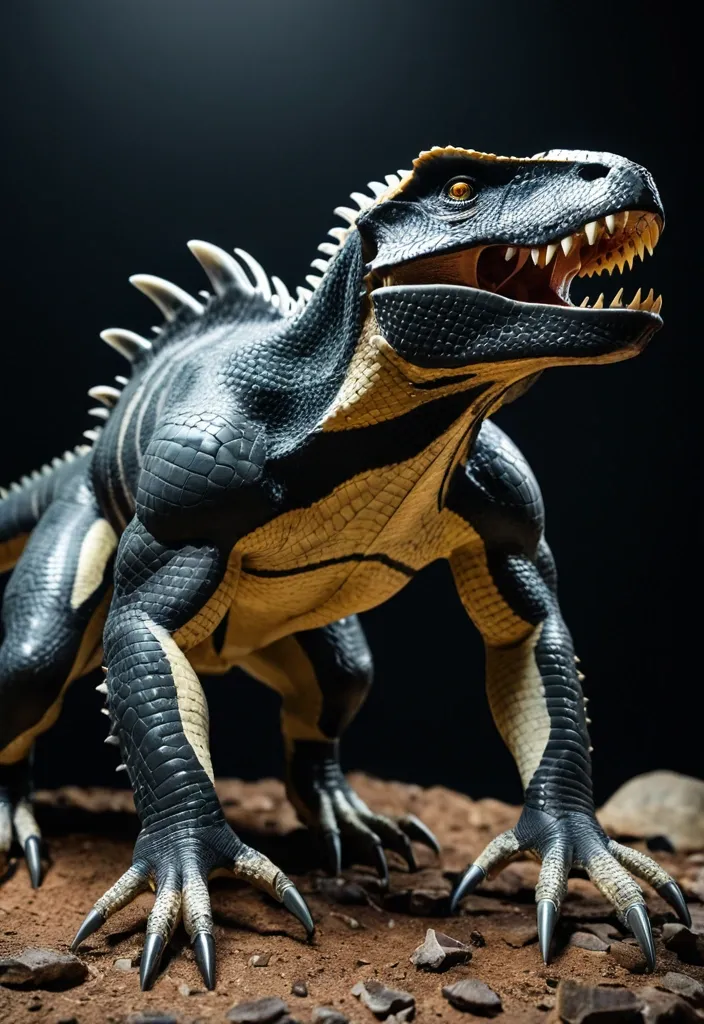
Physical Characteristics: Size & Build: Towering at around 15 feet tall and 40 feet long , Venenosus Rex exhibits a robust , muscular build with bulky , reduced hind legs adapted for powerful knuckle-walking quadrupedal locomotion , inherited from its Ape DNA. Its stance is low and intimidating , allowing swift bursts of speed and stability. Head: The head is a terrifying blend of Tyrannosaurus rex , Giganotosaurus , and Triceratops shapes—a broad , armored skull with a reinforced bony frill and horn-like protrusions from Triceratops , providing natural defense. Its jaw can open up to 90 degrees , snake-like , capable of delivering crushing bites able to shatter bulletproof glass. Skin & Camouflage: Covered in thick , overlapping Scelidosaurus-like osteoderm armor plates along the back and flanks , providing excellent protection against attacks. The skin contains chromatophore cells from cuttlefish DNA , allowing Venenosus Rex to dynamically change skin color , texture , and pattern for camouflage or intimidation. Arms & Claws: Long , powerful arms inspired by Saurophaganax and Ape DNA end in razor-sharp , hooked claws capable of slashing through armored prey and wielding tools for complex hunting strategies. Teeth & Fangs: Teeth are a deadly combination from the Inland Taipan’s retractable fangs , Komodo Dragon’s serrated teeth , and Northern short-tailed shrew’s sharp incisors , allowing it to pierce armor and inject highly toxic saliva into prey. Eyes & Senses: Equipped with specialized cranial cavities housing infrared vision , enabling night hunting and detection of body heat signatures. Its olfactory and auditory senses are exceptionally refined due to Utahraptor and Komodo Dragon ancestry. Unique Abilities: Extreme Environmental Resistance: Thanks to Tardigrade , Opossum , and Mongoose DNA , Venenosus Rex can survive extreme temperatures , radiation , dehydration , starvation , and bacterial infections. Its organs are shielded by trehalose gel , and its DNA is protected by specialized proteins against radiation damage. It can slow its metabolism down to 0.01% of normal , entering a near-hibernative state during harsh conditions. Toxic Saliva & Venom: Its saliva contains potent neurotoxins and anticoagulants , ensuring even minor bites are deadly over time. Combined with its retractable fangs , it can efficiently incapacitate prey or rivals. Camouflage & Stealth: Dynamic skin color and texture changes allow it to blend seamlessly into diverse environments or mimic threatening patterns to intimidate. Intelligence & Pack Hunting: Enhanced Utahraptor DNA grants high cognitive abilities , including planning , problem-solving , and social pack hunting tactics , making it a highly strategic predator. Tool Use: The combination of long , dexterous arms and ape DNA allows it to manipulate objects , set traps , or use environmental tools during hunts. Wide Jaw Opening: The ability to open its jaw at a 90-degree angle allows for impressive bite range and prey handling , intimidating foes with sudden wide gapes. ,
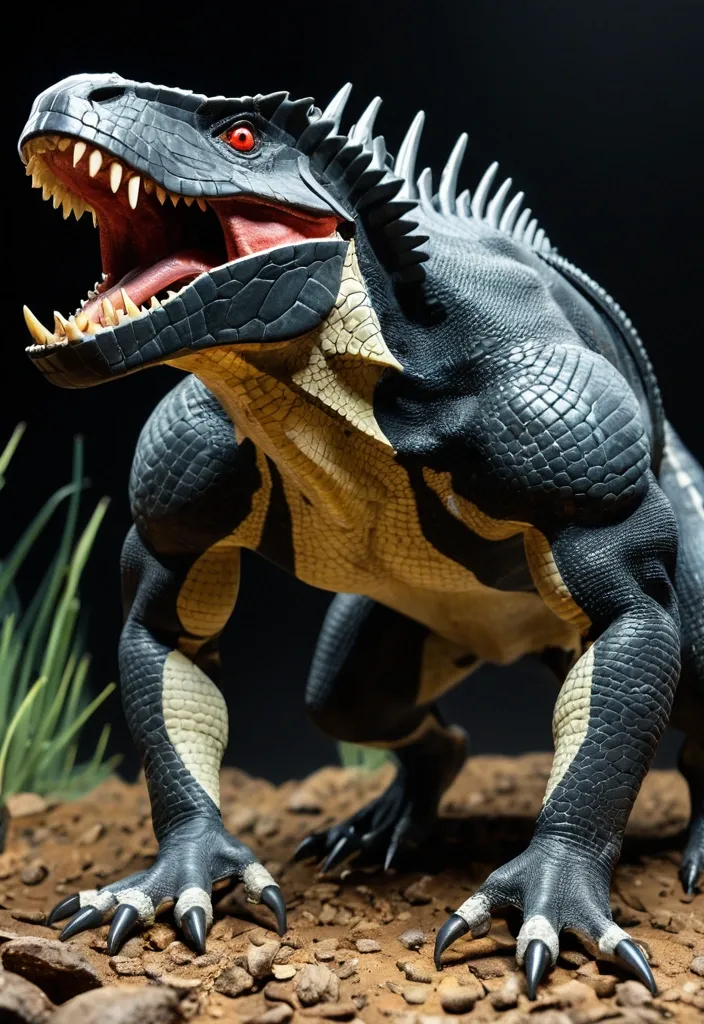
Physical Characteristics: Size & Build: Towering at around 15 feet tall and 40 feet long , Venenosus Rex exhibits a robust , muscular build with bulky , reduced hind legs adapted for powerful knuckle-walking quadrupedal locomotion , inherited from its Ape DNA. Its stance is low and intimidating , allowing swift bursts of speed and stability. Head: The head is a terrifying blend of Tyrannosaurus rex , Giganotosaurus , and Triceratops shapes—a broad , armored skull with a reinforced bony frill and horn-like protrusions from Triceratops , providing natural defense. Its jaw can open up to 90 degrees , snake-like , capable of delivering crushing bites able to shatter bulletproof glass. Skin & Camouflage: Covered in thick , overlapping Scelidosaurus-like osteoderm armor plates along the back and flanks , providing excellent protection against attacks. The skin contains chromatophore cells from cuttlefish DNA , allowing Venenosus Rex to dynamically change skin color , texture , and pattern for camouflage or intimidation. Arms & Claws: Long , powerful arms inspired by Saurophaganax and Ape DNA end in razor-sharp , hooked claws capable of slashing through armored prey and wielding tools for complex hunting strategies. Teeth & Fangs: Teeth are a deadly combination from the Inland Taipan’s retractable fangs , Komodo Dragon’s serrated teeth , and Northern short-tailed shrew’s sharp incisors , allowing it to pierce armor and inject highly toxic saliva into prey. Eyes & Senses: Equipped with specialized cranial cavities housing infrared vision , enabling night hunting and detection of body heat signatures. Its olfactory and auditory senses are exceptionally refined due to Utahraptor and Komodo Dragon ancestry. Unique Abilities: Extreme Environmental Resistance: Thanks to Tardigrade , Opossum , and Mongoose DNA , Venenosus Rex can survive extreme temperatures , radiation , dehydration , starvation , and bacterial infections. Its organs are shielded by trehalose gel , and its DNA is protected by specialized proteins against radiation damage. It can slow its metabolism down to 0.01% of normal , entering a near-hibernative state during harsh conditions. Toxic Saliva & Venom: Its saliva contains potent neurotoxins and anticoagulants , ensuring even minor bites are deadly over time. Combined with its retractable fangs , it can efficiently incapacitate prey or rivals. Camouflage & Stealth: Dynamic skin color and texture changes allow it to blend seamlessly into diverse environments or mimic threatening patterns to intimidate. Intelligence & Pack Hunting: Enhanced Utahraptor DNA grants high cognitive abilities , including planning , problem-solving , and social pack hunting tactics , making it a highly strategic predator. Tool Use: The combination of long , dexterous arms and ape DNA allows it to manipulate objects , set traps , or use environmental tools during hunts. Wide Jaw Opening: The ability to open its jaw at a 90-degree angle allows for impressive bite range and prey handling , intimidating foes with sudden wide gapes. ,
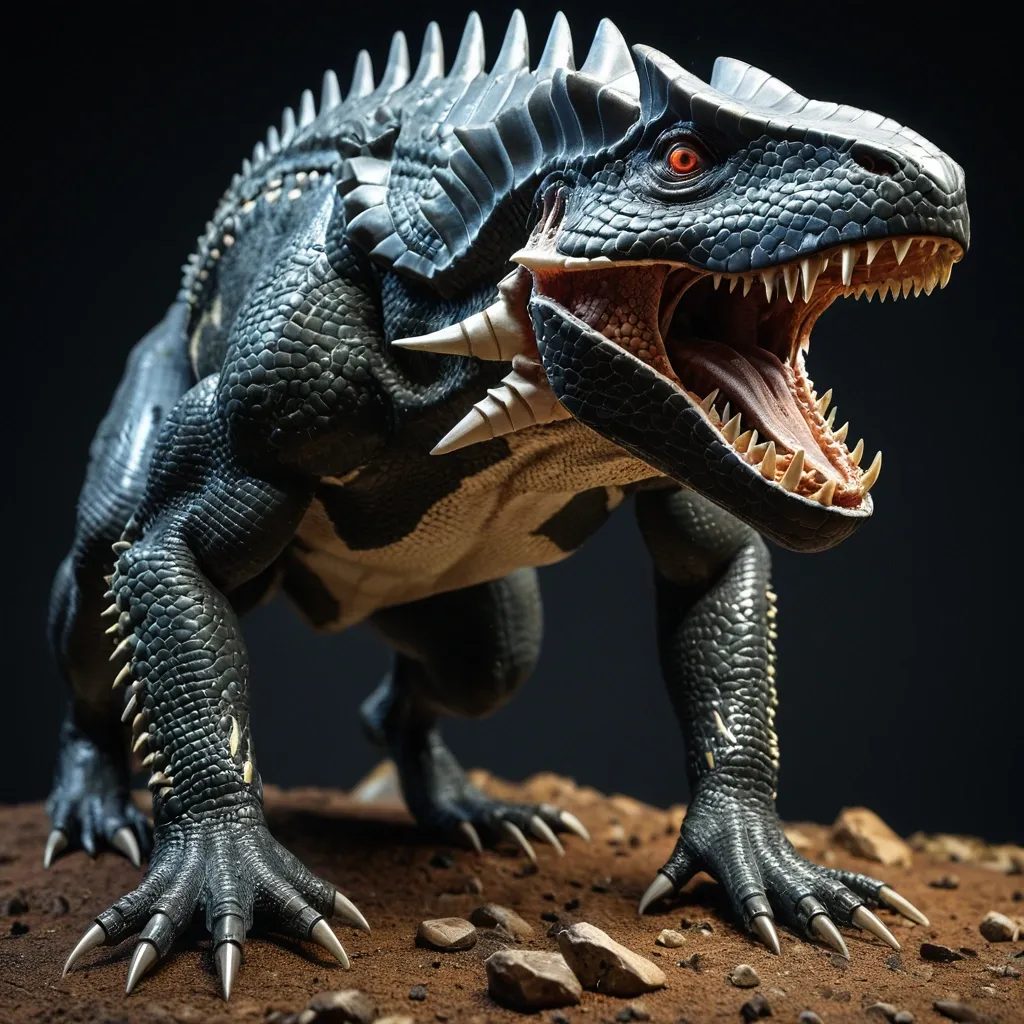
Physical Characteristics: Size & Build: Towering at around 15 feet tall and 40 feet long , Venenosus Rex exhibits a robust , muscular build with bulky , reduced hind legs adapted for powerful knuckle-walking quadrupedal locomotion , inherited from its Ape DNA. Its stance is low and intimidating , allowing swift bursts of speed and stability. Head: The head is a terrifying blend of Tyrannosaurus rex , Giganotosaurus , and Triceratops shapes—a broad , armored skull with a reinforced bony frill and horn-like protrusions from Triceratops , providing natural defense. Its jaw can open up to 90 degrees , snake-like , capable of delivering crushing bites able to shatter bulletproof glass. Skin & Camouflage: Covered in thick , overlapping Scelidosaurus-like osteoderm armor plates along the back and flanks , providing excellent protection against attacks. The skin contains chromatophore cells from cuttlefish DNA , allowing Venenosus Rex to dynamically change skin color , texture , and pattern for camouflage or intimidation. Arms & Claws: Long , powerful arms inspired by Saurophaganax and Ape DNA end in razor-sharp , hooked claws capable of slashing through armored prey and wielding tools for complex hunting strategies. Teeth & Fangs: Teeth are a deadly combination from the Inland Taipan’s retractable fangs , Komodo Dragon’s serrated teeth , and Northern short-tailed shrew’s sharp incisors , allowing it to pierce armor and inject highly toxic saliva into prey. Eyes & Senses: Equipped with specialized cranial cavities housing infrared vision , enabling night hunting and detection of body heat signatures. Its olfactory and auditory senses are exceptionally refined due to Utahraptor and Komodo Dragon ancestry. Unique Abilities: Extreme Environmental Resistance: Thanks to Tardigrade , Opossum , and Mongoose DNA , Venenosus Rex can survive extreme temperatures , radiation , dehydration , starvation , and bacterial infections. Its organs are shielded by trehalose gel , and its DNA is protected by specialized proteins against radiation damage. It can slow its metabolism down to 0.01% of normal , entering a near-hibernative state during harsh conditions. Toxic Saliva & Venom: Its saliva contains potent neurotoxins and anticoagulants , ensuring even minor bites are deadly over time. Combined with its retractable fangs , it can efficiently incapacitate prey or rivals. Camouflage & Stealth: Dynamic skin color and texture changes allow it to blend seamlessly into diverse environments or mimic threatening patterns to intimidate. Intelligence & Pack Hunting: Enhanced Utahraptor DNA grants high cognitive abilities , including planning , problem-solving , and social pack hunting tactics , making it a highly strategic predator. Tool Use: The combination of long , dexterous arms and ape DNA allows it to manipulate objects , set traps , or use environmental tools during hunts. Wide Jaw Opening: The ability to open its jaw at a 90-degree angle allows for impressive bite range and prey handling , intimidating foes with sudden wide gapes. ,
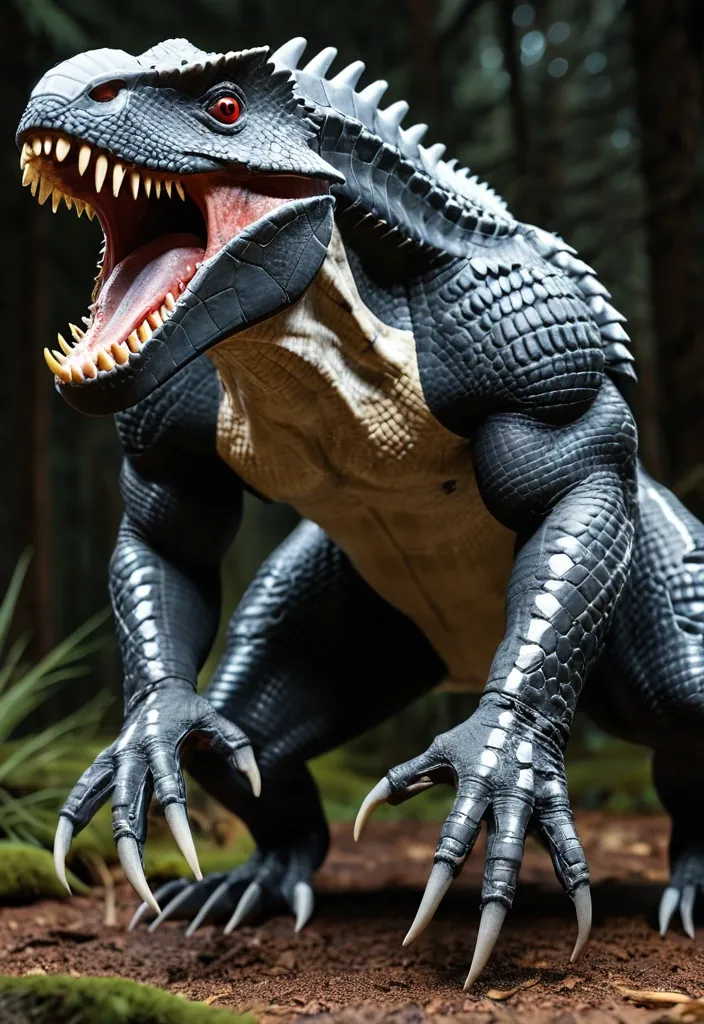
Physical Characteristics: Size & Build: Towering at around 15 feet tall and 40 feet long , Venenosus Rex exhibits a robust , muscular build with bulky , reduced hind legs adapted for powerful knuckle-walking quadrupedal locomotion , inherited from its Ape DNA. Its stance is low and intimidating , allowing swift bursts of speed and stability. Head: The head is a terrifying blend of Tyrannosaurus rex , Giganotosaurus , and Triceratops shapes—a broad , armored skull with a reinforced bony frill and horn-like protrusions from Triceratops , providing natural defense. Its jaw can open up to 90 degrees , snake-like , capable of delivering crushing bites able to shatter bulletproof glass. Skin & Camouflage: Covered in thick , overlapping Scelidosaurus-like osteoderm armor plates along the back and flanks , providing excellent protection against attacks. The skin contains chromatophore cells from cuttlefish DNA , allowing Venenosus Rex to dynamically change skin color , texture , and pattern for camouflage or intimidation. Arms & Claws: Long , powerful arms inspired by Saurophaganax and Ape DNA end in razor-sharp , hooked claws capable of slashing through armored prey and wielding tools for complex hunting strategies. Teeth & Fangs: Teeth are a deadly combination from the Inland Taipan’s retractable fangs , Komodo Dragon’s serrated teeth , and Northern short-tailed shrew’s sharp incisors , allowing it to pierce armor and inject highly toxic saliva into prey. Eyes & Senses: Equipped with specialized cranial cavities housing infrared vision , enabling night hunting and detection of body heat signatures. Its olfactory and auditory senses are exceptionally refined due to Utahraptor and Komodo Dragon ancestry. Unique Abilities: Extreme Environmental Resistance: Thanks to Tardigrade , Opossum , and Mongoose DNA , Venenosus Rex can survive extreme temperatures , radiation , dehydration , starvation , and bacterial infections. Its organs are shielded by trehalose gel , and its DNA is protected by specialized proteins against radiation damage. It can slow its metabolism down to 0.01% of normal , entering a near-hibernative state during harsh conditions. Toxic Saliva & Venom: Its saliva contains potent neurotoxins and anticoagulants , ensuring even minor bites are deadly over time. Combined with its retractable fangs , it can efficiently incapacitate prey or rivals. Camouflage & Stealth: Dynamic skin color and texture changes allow it to blend seamlessly into diverse environments or mimic threatening patterns to intimidate. Intelligence & Pack Hunting: Enhanced Utahraptor DNA grants high cognitive abilities , including planning , problem-solving , and social pack hunting tactics , making it a highly strategic predator. Tool Use: The combination of long , dexterous arms and ape DNA allows it to manipulate objects , set traps , or use environmental tools during hunts. Wide Jaw Opening: The ability to open its jaw at a 90-degree angle allows for impressive bite range and prey handling , intimidating foes with sudden wide gapes. ,
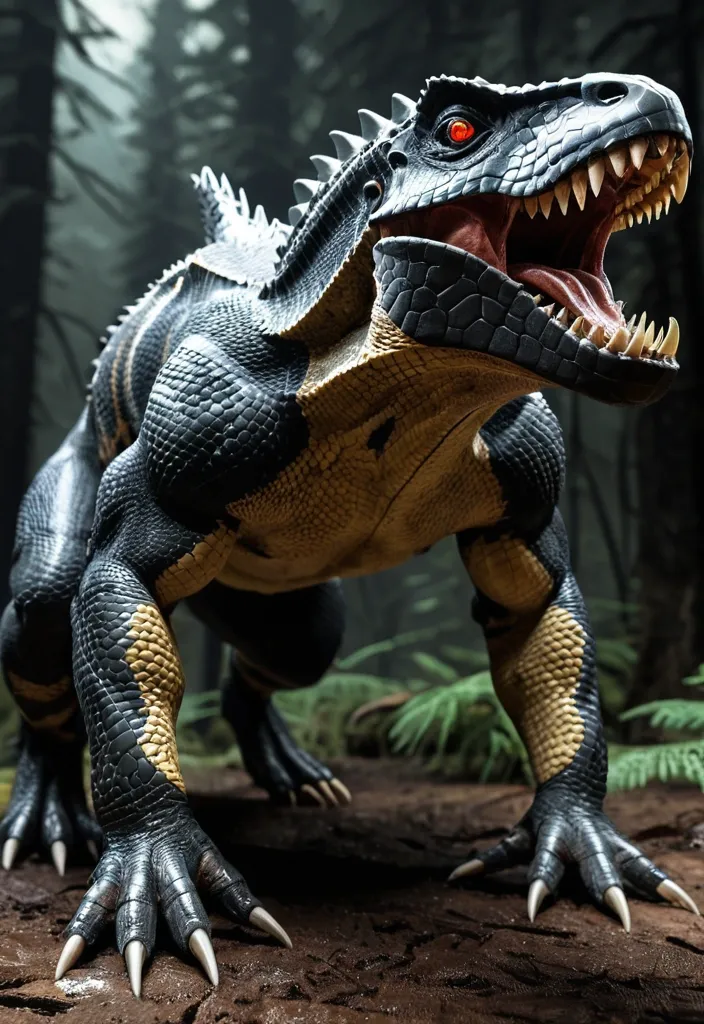
Physical Characteristics: Size & Build: Towering at around 15 feet tall and 40 feet long , Venenosus Rex exhibits a robust , muscular build with bulky , reduced hind legs adapted for powerful knuckle-walking quadrupedal locomotion , inherited from its Ape DNA. Its stance is low and intimidating , allowing swift bursts of speed and stability. Head: The head is a terrifying blend of Tyrannosaurus rex , Giganotosaurus , and Triceratops shapes—a broad , armored skull with a reinforced bony frill and horn-like protrusions from Triceratops , providing natural defense. Its jaw can open up to 90 degrees , snake-like , capable of delivering crushing bites able to shatter bulletproof glass. Skin & Camouflage: Covered in thick , overlapping Scelidosaurus-like osteoderm armor plates along the back and flanks , providing excellent protection against attacks. The skin contains chromatophore cells from cuttlefish DNA , allowing Venenosus Rex to dynamically change skin color , texture , and pattern for camouflage or intimidation. Arms & Claws: Long , powerful arms inspired by Saurophaganax and Ape DNA end in razor-sharp , hooked claws capable of slashing through armored prey and wielding tools for complex hunting strategies. Teeth & Fangs: Teeth are a deadly combination from the Inland Taipan’s retractable fangs , Komodo Dragon’s serrated teeth , and Northern short-tailed shrew’s sharp incisors , allowing it to pierce armor and inject highly toxic saliva into prey. Eyes & Senses: Equipped with specialized cranial cavities housing infrared vision , enabling night hunting and detection of body heat signatures. Its olfactory and auditory senses are exceptionally refined due to Utahraptor and Komodo Dragon ancestry. Unique Abilities: Extreme Environmental Resistance: Thanks to Tardigrade , Opossum , and Mongoose DNA , Venenosus Rex can survive extreme temperatures , radiation , dehydration , starvation , and bacterial infections. Its organs are shielded by trehalose gel , and its DNA is protected by specialized proteins against radiation damage. It can slow its metabolism down to 0.01% of normal , entering a near-hibernative state during harsh conditions. Toxic Saliva & Venom: Its saliva contains potent neurotoxins and anticoagulants , ensuring even minor bites are deadly over time. Combined with its retractable fangs , it can efficiently incapacitate prey or rivals. Camouflage & Stealth: Dynamic skin color and texture changes allow it to blend seamlessly into diverse environments or mimic threatening patterns to intimidate. Intelligence & Pack Hunting: Enhanced Utahraptor DNA grants high cognitive abilities , including planning , problem-solving , and social pack hunting tactics , making it a highly strategic predator. Tool Use: The combination of long , dexterous arms and ape DNA allows it to manipulate objects , set traps , or use environmental tools during hunts. Wide Jaw Opening: The ability to open its jaw at a 90-degree angle allows for impressive bite range and prey handling , intimidating foes with sudden wide gapes. ,
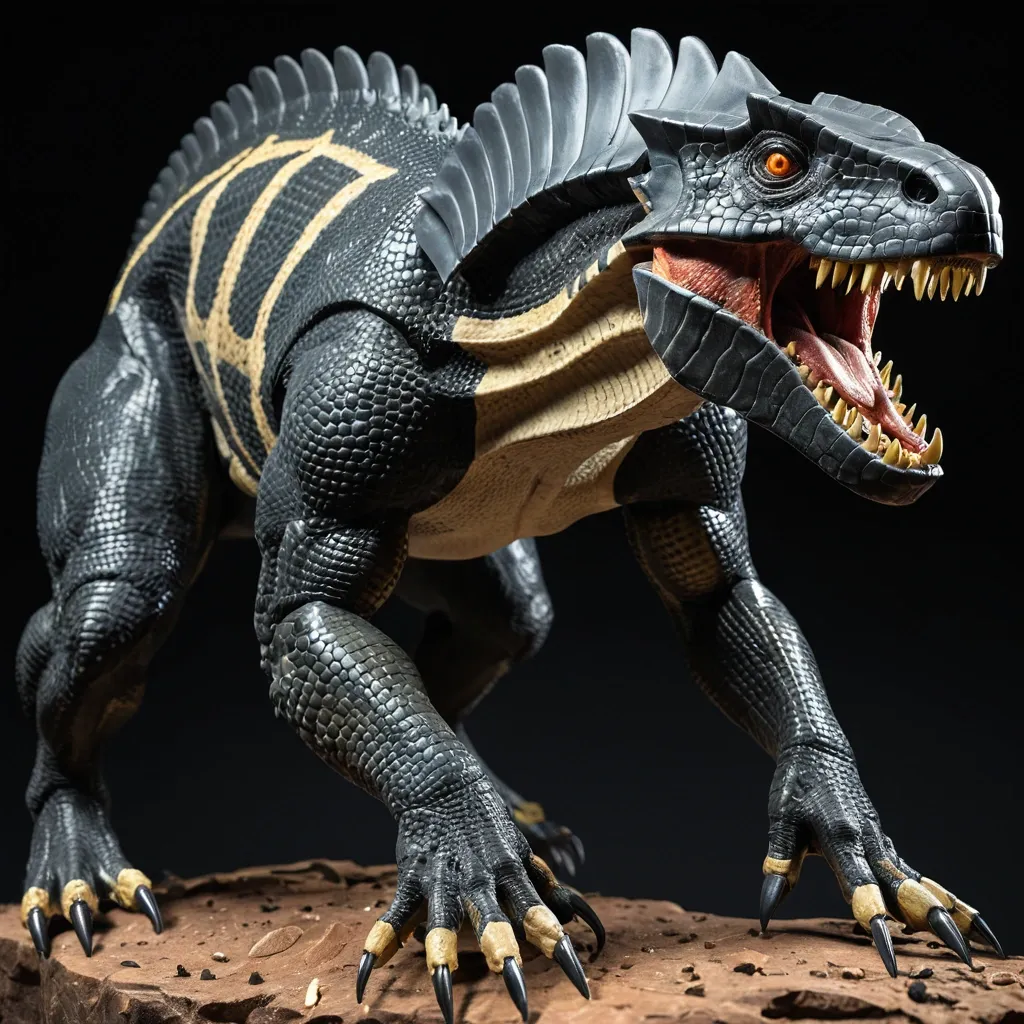
Physical Characteristics: Size & Build: Towering at around 15 feet tall and 40 feet long , Venenosus Rex exhibits a robust , muscular build with bulky , reduced hind legs adapted for powerful knuckle-walking quadrupedal locomotion , inherited from its Ape DNA. Its stance is low and intimidating , allowing swift bursts of speed and stability. Head: The head is a terrifying blend of Tyrannosaurus rex , Giganotosaurus , and Triceratops shapes—a broad , armored skull with a reinforced bony frill and horn-like protrusions from Triceratops , providing natural defense. Its jaw can open up to 90 degrees , snake-like , capable of delivering crushing bites able to shatter bulletproof glass. Skin & Camouflage: Covered in thick , overlapping Scelidosaurus-like osteoderm armor plates along the back and flanks , providing excellent protection against attacks. The skin contains chromatophore cells from cuttlefish DNA , allowing Venenosus Rex to dynamically change skin color , texture , and pattern for camouflage or intimidation. Arms & Claws: Long , powerful arms inspired by Saurophaganax and Ape DNA end in razor-sharp , hooked claws capable of slashing through armored prey and wielding tools for complex hunting strategies. Teeth & Fangs: Teeth are a deadly combination from the Inland Taipan’s retractable fangs , Komodo Dragon’s serrated teeth , and Northern short-tailed shrew’s sharp incisors , allowing it to pierce armor and inject highly toxic saliva into prey. Eyes & Senses: Equipped with specialized cranial cavities housing infrared vision , enabling night hunting and detection of body heat signatures. Its olfactory and auditory senses are exceptionally refined due to Utahraptor and Komodo Dragon ancestry. Unique Abilities: Extreme Environmental Resistance: Thanks to Tardigrade , Opossum , and Mongoose DNA , Venenosus Rex can survive extreme temperatures , radiation , dehydration , starvation , and bacterial infections. Its organs are shielded by trehalose gel , and its DNA is protected by specialized proteins against radiation damage. It can slow its metabolism down to 0.01% of normal , entering a near-hibernative state during harsh conditions. Toxic Saliva & Venom: Its saliva contains potent neurotoxins and anticoagulants , ensuring even minor bites are deadly over time. Combined with its retractable fangs , it can efficiently incapacitate prey or rivals. Camouflage & Stealth: Dynamic skin color and texture changes allow it to blend seamlessly into diverse environments or mimic threatening patterns to intimidate. Intelligence & Pack Hunting: Enhanced Utahraptor DNA grants high cognitive abilities , including planning , problem-solving , and social pack hunting tactics , making it a highly strategic predator. Tool Use: The combination of long , dexterous arms and ape DNA allows it to manipulate objects , set traps , or use environmental tools during hunts. Wide Jaw Opening: The ability to open its jaw at a 90-degree angle allows for impressive bite range and prey handling , intimidating foes with sudden wide gapes. ,
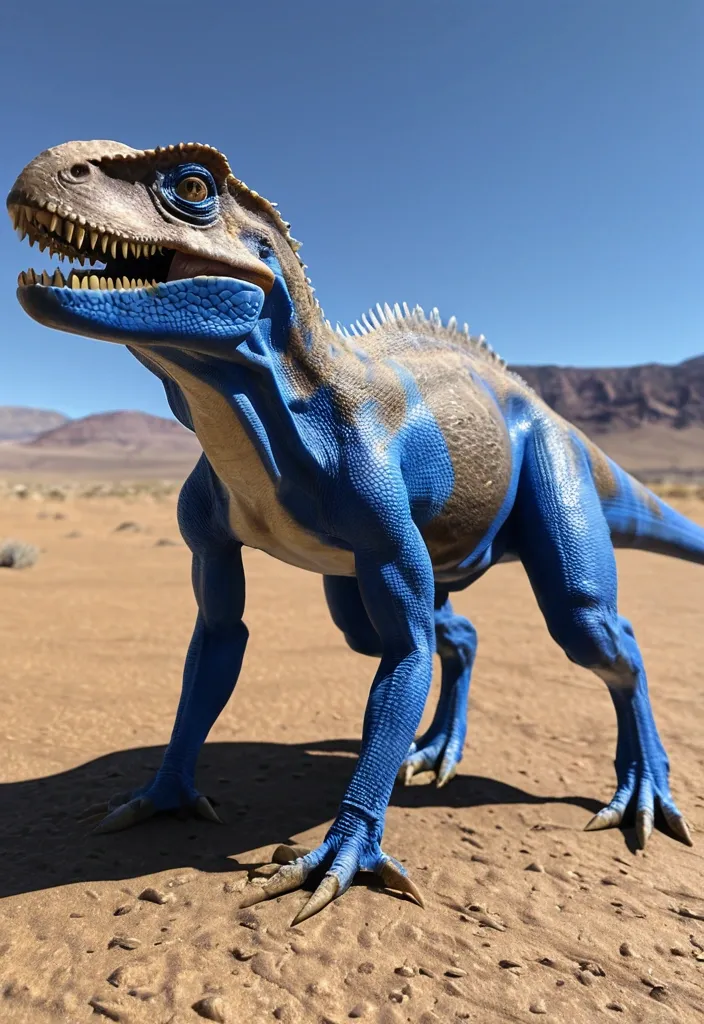
The hybrid was created by modifying the genome of a Tyrannosaurus rex , with the DNA of three other theropod species that were Utahraptor , Saurophaganax , and Giganotosaurus. Also the DNA of Quadrupes like Triceratops , Scelidosaurus , Gigantopithecus. DNA of modern animals such as Greater blue-ringed octopus , Inland Taipan , Northern Short-tailed Shrew , Komodo Dragon , Opossum , Mongoose , Whiptail Lizard , Cuttlefish , and Tardigrades. The genome of Tyrannosaurus rex , Utahraptor , Saurophaganax , and Giganotosaurus was used as the base genome for the hybrid. The shape of the headcrest is from the Triceratops. Utahraptor DNA was added for high levels of intelligence and the ability to make plans , decisions and pack hunting. Gigantopithecus DNA added for Knuckle-walking. Triceratops , and Scelidosaurus armor added a biological form of armor that absorbed most of the incoming attacks. Northern short-tailed shrew iron teeth , the Inland taipan's retractable fangs and the Komodo Dragon serrated teeth genome was used to form the teething of the hybrid. Saurophaganax and Gigantopithecus DNA added the presence of long strong arms with slashing hook claws and the use of tools. Cuttlefish genes were intended to help the hybrid withstand an accelerated growth , but it also added chromatophore cells in the skin so it could change the shape , color , and texture of its skin like a cuttlefish. Opossum , Mongoose and Tardigrades DNA was added for the hybrid to be more resistant to climate changes , harmful toxins or bacterial infections , while tardigrades also added survival of extreme conditions such as exposure to extreme temperatures , extreme pressures , air deprivation , radiation , dehydration , and starvation. Northern short-tailed shrew , the Inland Taipan , Greater blue-ringed octopus and the Komodo Dragon's DNA also added special cavities and glands in the skull that gave her infrared vision , and highly toxic saliva. Said DNA also gave her the ability to open her mandibles and jaws as wide as a snake , specifically at around 90 degrees.Lastly , DNA from a whiptail lizard was added for reproduction purposes. ,

The hybrid was created by modifying the genome of a Tyrannosaurus rex , with the DNA of three other theropod species that were Utahraptor , Saurophaganax , and Giganotosaurus. Also the DNA of Quadrupes like Triceratops , Scelidosaurus , Gigantopithecus. DNA of modern animals such as Greater blue-ringed octopus , Inland Taipan , Northern Short-tailed Shrew , Komodo Dragon , Opossum , Mongoose , Whiptail Lizard , Cuttlefish , and Tardigrades. The genome of Tyrannosaurus rex , Utahraptor , Saurophaganax , and Giganotosaurus was used as the base genome for the hybrid. The shape of the headcrest is from the Triceratops. Utahraptor DNA was added for high levels of intelligence and the ability to make plans , decisions and pack hunting. Gigantopithecus DNA added for Knuckle-walking. Triceratops , and Scelidosaurus armor added a biological form of armor that absorbed most of the incoming attacks. Northern short-tailed shrew iron teeth , the Inland taipan's retractable fangs and the Komodo Dragon serrated teeth genome was used to form the teething of the hybrid. Saurophaganax and Gigantopithecus DNA added the presence of long strong arms with slashing hook claws and the use of tools. Cuttlefish genes were intended to help the hybrid withstand an accelerated growth , but it also added chromatophore cells in the skin so it could change the shape , color , and texture of its skin like a cuttlefish. Opossum , Mongoose and Tardigrades DNA was added for the hybrid to be more resistant to climate changes , harmful toxins or bacterial infections , while tardigrades also added survival of extreme conditions such as exposure to extreme temperatures , extreme pressures , air deprivation , radiation , dehydration , and starvation. Northern short-tailed shrew , the Inland Taipan , Greater blue-ringed octopus and the Komodo Dragon's DNA also added special cavities and glands in the skull that gave her infrared vision , and highly toxic saliva. Said DNA also gave her the ability to open her mandibles and jaws as wide as a snake , specifically at around 90 degrees.Lastly , DNA from a whiptail lizard was added for reproduction purposes. ,
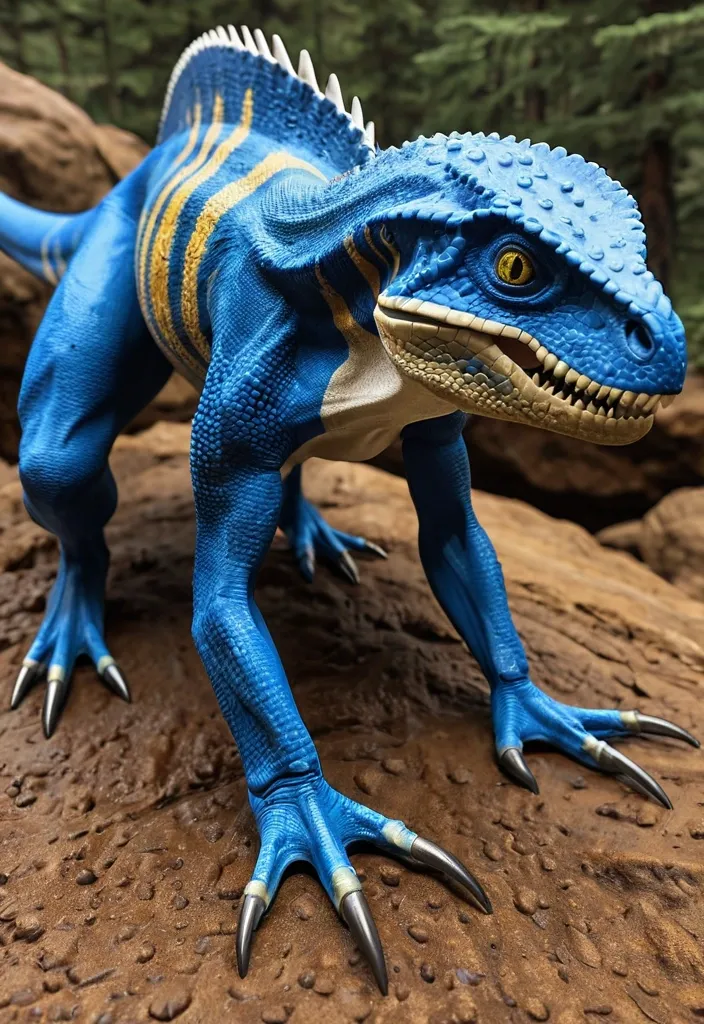
The hybrid was created by modifying the genome of a Tyrannosaurus rex , with the DNA of three other theropod species that were Utahraptor , Saurophaganax , and Giganotosaurus. Also the DNA of Quadrupes like Triceratops , Scelidosaurus , Gigantopithecus. DNA of modern animals such as Greater blue-ringed octopus , Inland Taipan , Northern Short-tailed Shrew , Komodo Dragon , Opossum , Mongoose , Whiptail Lizard , Cuttlefish , and Tardigrades. The genome of Tyrannosaurus rex , Utahraptor , Saurophaganax , and Giganotosaurus was used as the base genome for the hybrid. The shape of the headcrest is from the Triceratops. Utahraptor DNA was added for high levels of intelligence and the ability to make plans , decisions and pack hunting. Gigantopithecus DNA added for Knuckle-walking. Triceratops , and Scelidosaurus armor added a biological form of armor that absorbed most of the incoming attacks. Northern short-tailed shrew iron teeth , the Inland taipan's retractable fangs and the Komodo Dragon serrated teeth genome was used to form the teething of the hybrid. Saurophaganax and Gigantopithecus DNA added the presence of long strong arms with slashing hook claws and the use of tools. Cuttlefish genes were intended to help the hybrid withstand an accelerated growth , but it also added chromatophore cells in the skin so it could change the shape , color , and texture of its skin like a cuttlefish. Opossum , Mongoose and Tardigrades DNA was added for the hybrid to be more resistant to climate changes , harmful toxins or bacterial infections , while tardigrades also added survival of extreme conditions such as exposure to extreme temperatures , extreme pressures , air deprivation , radiation , dehydration , and starvation. Northern short-tailed shrew , the Inland Taipan , Greater blue-ringed octopus and the Komodo Dragon's DNA also added special cavities and glands in the skull that gave her infrared vision , and highly toxic saliva. Said DNA also gave her the ability to open her mandibles and jaws as wide as a snake , specifically at around 90 degrees.Lastly , DNA from a whiptail lizard was added for reproduction purposes. ,
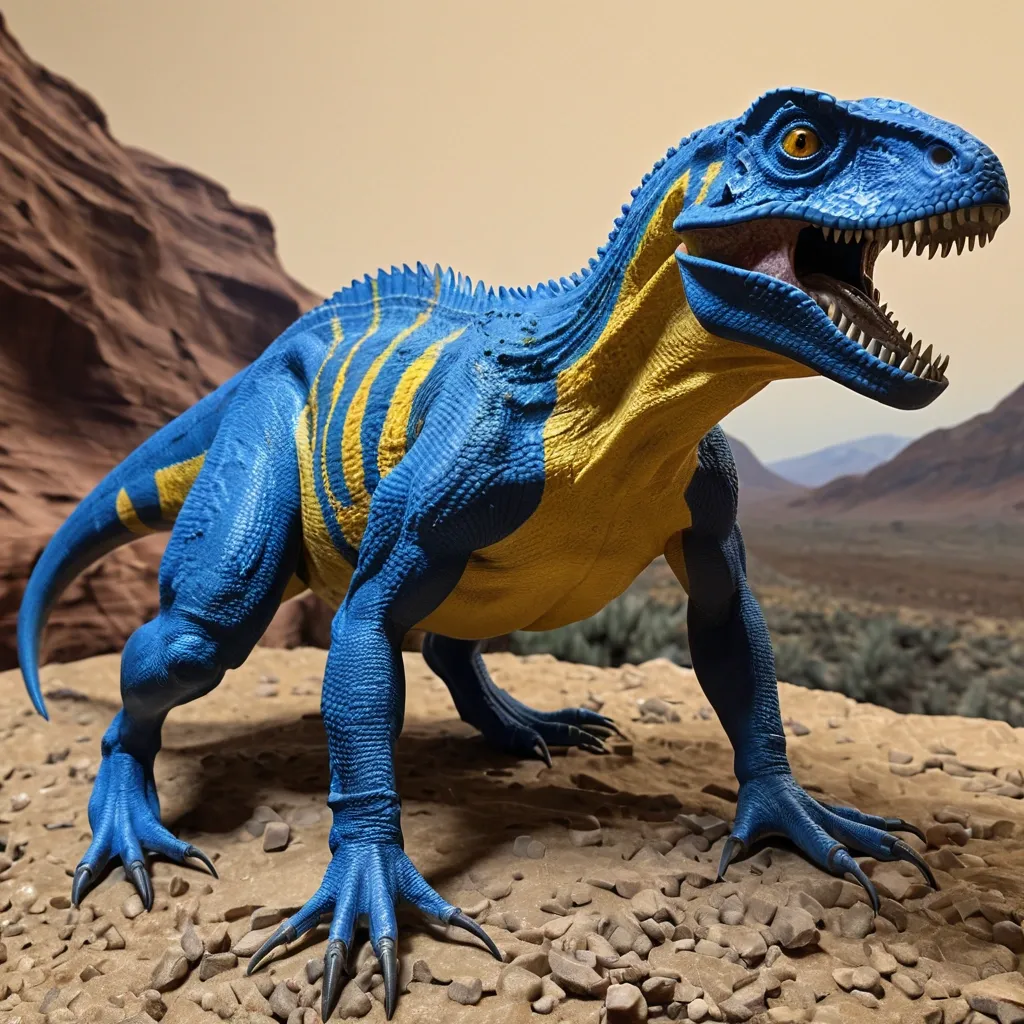
The hybrid was created by modifying the genome of a Tyrannosaurus rex , with the DNA of three other theropod species that were Utahraptor , Saurophaganax , and Giganotosaurus. Also the DNA of Quadrupes like Triceratops , Scelidosaurus , Gigantopithecus. DNA of modern animals such as Greater blue-ringed octopus , Inland Taipan , Northern Short-tailed Shrew , Komodo Dragon , Opossum , Mongoose , Whiptail Lizard , Cuttlefish , and Tardigrades. The genome of Tyrannosaurus rex , Utahraptor , Saurophaganax , and Giganotosaurus was used as the base genome for the hybrid. The shape of the headcrest is from the Triceratops. Utahraptor DNA was added for high levels of intelligence and the ability to make plans , decisions and pack hunting. Gigantopithecus DNA added for Knuckle-walking. Triceratops , and Scelidosaurus armor added a biological form of armor that absorbed most of the incoming attacks. Northern short-tailed shrew iron teeth , the Inland taipan's retractable fangs and the Komodo Dragon serrated teeth genome was used to form the teething of the hybrid. Saurophaganax and Gigantopithecus DNA added the presence of long strong arms with slashing hook claws and the use of tools. Cuttlefish genes were intended to help the hybrid withstand an accelerated growth , but it also added chromatophore cells in the skin so it could change the shape , color , and texture of its skin like a cuttlefish. Opossum , Mongoose and Tardigrades DNA was added for the hybrid to be more resistant to climate changes , harmful toxins or bacterial infections , while tardigrades also added survival of extreme conditions such as exposure to extreme temperatures , extreme pressures , air deprivation , radiation , dehydration , and starvation. Northern short-tailed shrew , the Inland Taipan , Greater blue-ringed octopus and the Komodo Dragon's DNA also added special cavities and glands in the skull that gave her infrared vision , and highly toxic saliva. Said DNA also gave her the ability to open her mandibles and jaws as wide as a snake , specifically at around 90 degrees.Lastly , DNA from a whiptail lizard was added for reproduction purposes. ,
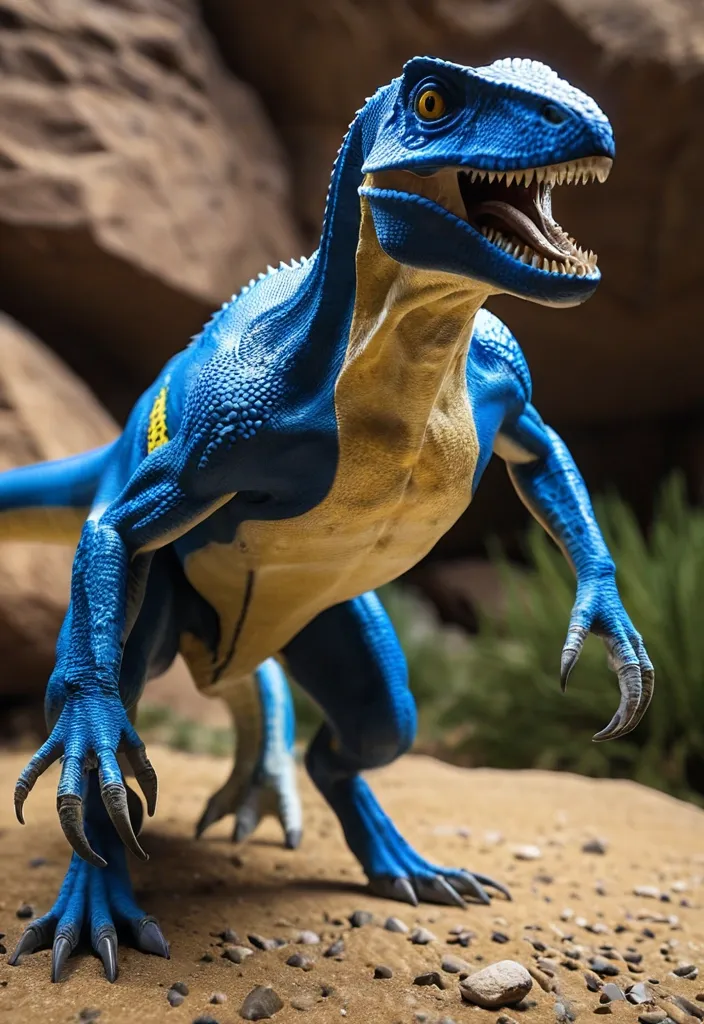
The hybrid was created by modifying the genome of a Tyrannosaurus rex , with the DNA of three other theropod species that were Utahraptor , Saurophaganax , and Giganotosaurus. Also the DNA of Quadrupes like Triceratops , Scelidosaurus , Gigantopithecus. DNA of modern animals such as Greater blue-ringed octopus , Inland Taipan , Northern Short-tailed Shrew , Komodo Dragon , Opossum , Mongoose , Whiptail Lizard , Cuttlefish , and Tardigrades. The genome of Tyrannosaurus rex , Utahraptor , Saurophaganax , and Giganotosaurus was used as the base genome for the hybrid. The shape of the headcrest is from the Triceratops. Utahraptor DNA was added for high levels of intelligence and the ability to make plans , decisions and pack hunting. Gigantopithecus DNA added for Knuckle-walking. Triceratops , and Scelidosaurus armor added a biological form of armor that absorbed most of the incoming attacks. Northern short-tailed shrew iron teeth , the Inland taipan's retractable fangs and the Komodo Dragon serrated teeth genome was used to form the teething of the hybrid. Saurophaganax and Gigantopithecus DNA added the presence of long strong arms with slashing hook claws and the use of tools. Cuttlefish genes were intended to help the hybrid withstand an accelerated growth , but it also added chromatophore cells in the skin so it could change the shape , color , and texture of its skin like a cuttlefish. Opossum , Mongoose and Tardigrades DNA was added for the hybrid to be more resistant to climate changes , harmful toxins or bacterial infections , while tardigrades also added survival of extreme conditions such as exposure to extreme temperatures , extreme pressures , air deprivation , radiation , dehydration , and starvation. Northern short-tailed shrew , the Inland Taipan , Greater blue-ringed octopus and the Komodo Dragon's DNA also added special cavities and glands in the skull that gave her infrared vision , and highly toxic saliva. Said DNA also gave her the ability to open her mandibles and jaws as wide as a snake , specifically at around 90 degrees.Lastly , DNA from a whiptail lizard was added for reproduction purposes. ,
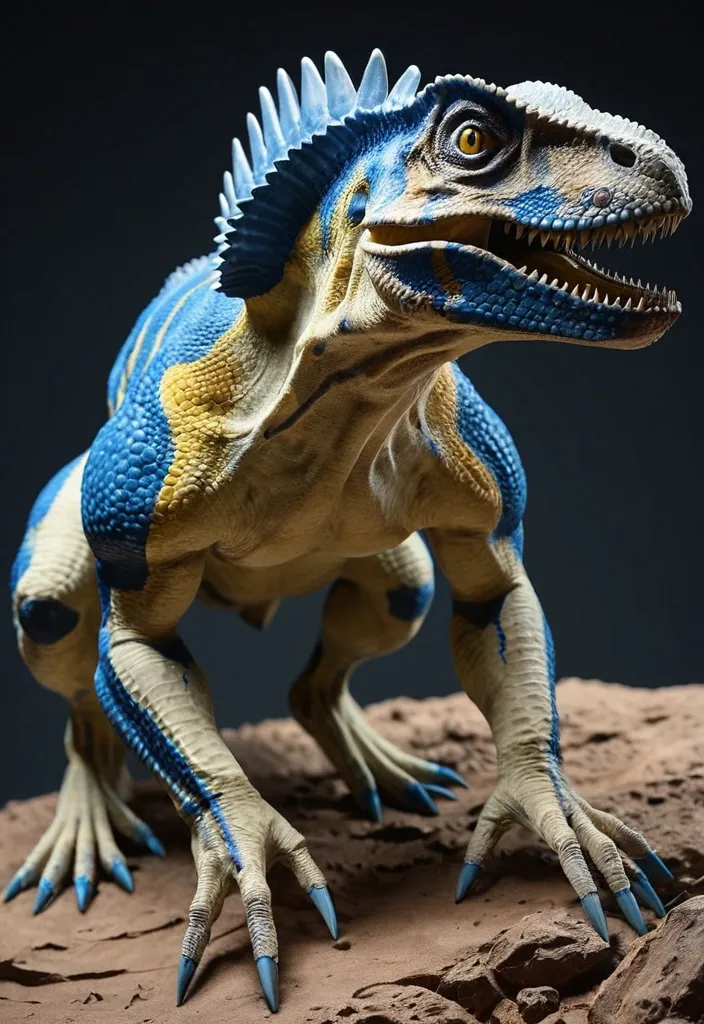
The hybrid was created by modifying the genome of a Tyrannosaurus rex , with the DNA of three other theropod species that were Utahraptor , Saurophaganax , and Giganotosaurus. Also the DNA of Quadrupes like Triceratops , and Scelidosaurus. DNA of modern animals such as Greater blue-ringed octopus , Inland Taipan , Northern Short-tailed Shrew , Komodo Dragon , Opossum , Mongoose , Gigantopithecus , Whiptail Lizard , Cuttlefish , and Tardigrades. The genome of Tyrannosaurus rex , Triceratops and Giganotosaurus was used as the base genome for the hybrid. Including the shape of the head in some parts from Giganotosaurus and Triceratops. Utahraptor DNA was added for high levels of intelligence and the ability to make plans , decisions and pack hunting. Reduced hind legs and Ape DNA added Knuckle-walking Quadruped. Triceratops , and Scelidosaurus were added to act as a biological form of armor that absorbed most of the incoming attacks. Northern short-tailed shrew , the Inland taipan's retractable fangs and the Komodo Dragon DNA was used to form the teeth of the Indominus that were used to tear through the flesh and armor of opponents. Saurophaganax and Gigantopithecus DNA added the presence of long strong arms with slashing hook claws and the use of tools. A swipe of the hybrid's claws would take down bigger opponents. While using tools for smaller elusive prey. Cuttlefish genes were intended to help the Venenosus withstand an accelerated growth , but it also added chromatophore cells in the skin so it could change the shape , color , and texture of its skin like a cuttlefish. Opossum , Mongoose and Tardigrades DNA was added for the Venenosus to be more resistant to climate changes , harmful toxins or bacterial infections , while tardigrades also added survival of extreme conditions such as exposure to extreme temperatures , extreme pressures , air deprivation , radiation , dehydration , and starvation. They have several defense mechanisms , including: A metabolic rate that gets as low as 0.01 percent of the normal rate. Organs protected by a sugary gel called trehalose. A protein that shields their DNA from radiation harm. Synthesis of cryoprotectant in chilly temperatures to prevent the development of ice crystals.Northern short-tailed shrew , the Inland Taipan , Greater blue-ringed octopus and the Komodo Dragon's DNA also added special cavities and glands in the skull that gave her infrared vision , and highly toxic saliva. Said DNA also gave her the ability to open her mandibles and jaws as wide as a snake , specifically at around 90 degrees.Lastly , DNA from a whiptail lizard was added for reproduction purposes. ,
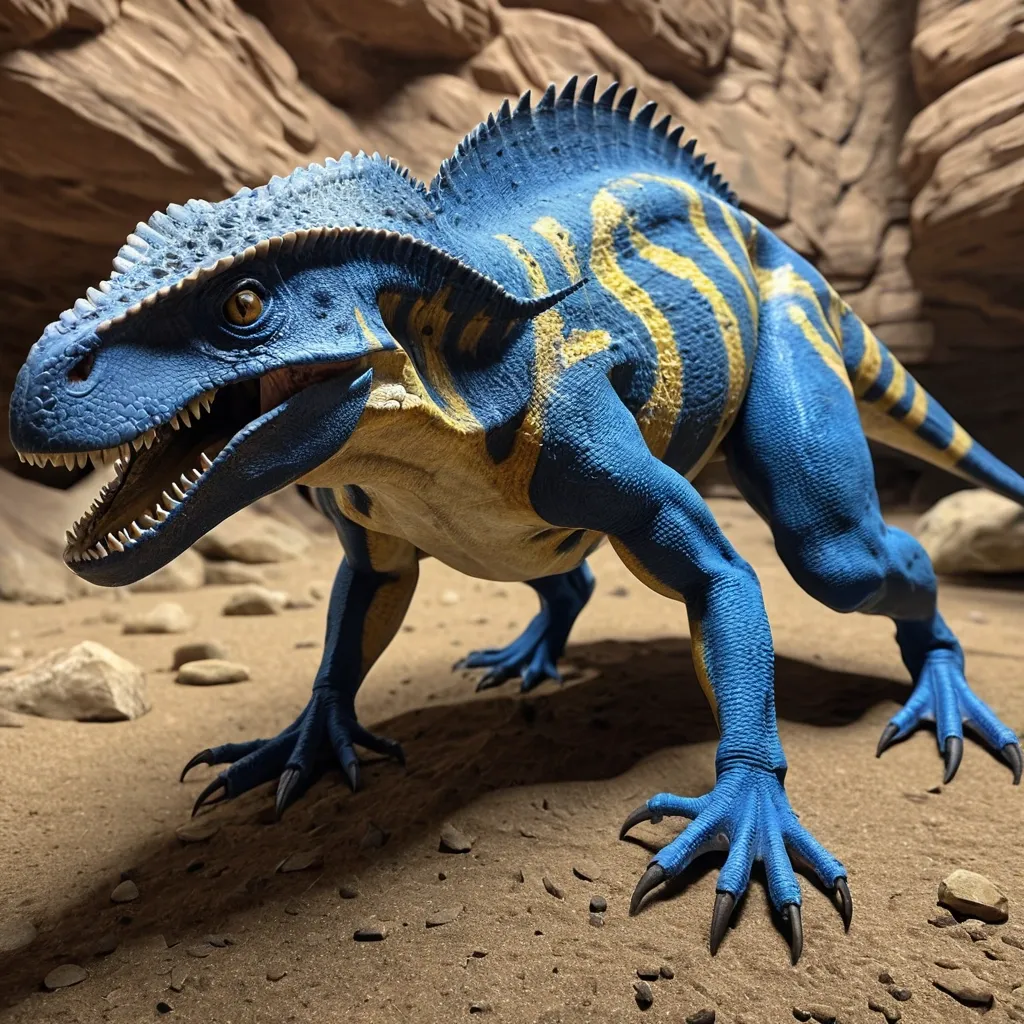
The hybrid was created by modifying the genome of a Tyrannosaurus rex , with the DNA of three other theropod species that were Utahraptor , Saurophaganax , and Giganotosaurus. Also the DNA of Quadrupes like Triceratops , and Scelidosaurus. DNA of modern animals such as Greater blue-ringed octopus , Inland Taipan , Northern Short-tailed Shrew , Komodo Dragon , Opossum , Mongoose , Gigantopithecus , Whiptail Lizard , Cuttlefish , and Tardigrades. The genome of Tyrannosaurus rex , Triceratops and Giganotosaurus was used as the base genome for the hybrid. Including the shape of the head in some parts from Giganotosaurus and Triceratops. Utahraptor DNA was added for high levels of intelligence and the ability to make plans , decisions and pack hunting. Reduced hind legs and Ape DNA added Knuckle-walking Quadruped. Triceratops , and Scelidosaurus were added to act as a biological form of armor that absorbed most of the incoming attacks. Northern short-tailed shrew , the Inland taipan's retractable fangs and the Komodo Dragon DNA was used to form the teeth of the Indominus that were used to tear through the flesh and armor of opponents. Saurophaganax and Gigantopithecus DNA added the presence of long strong arms with slashing hook claws and the use of tools. A swipe of the hybrid's claws would take down bigger opponents. While using tools for smaller elusive prey. Cuttlefish genes were intended to help the Venenosus withstand an accelerated growth , but it also added chromatophore cells in the skin so it could change the shape , color , and texture of its skin like a cuttlefish. Opossum , Mongoose and Tardigrades DNA was added for the Venenosus to be more resistant to climate changes , harmful toxins or bacterial infections , while tardigrades also added survival of extreme conditions such as exposure to extreme temperatures , extreme pressures , air deprivation , radiation , dehydration , and starvation. They have several defense mechanisms , including: A metabolic rate that gets as low as 0.01 percent of the normal rate. Organs protected by a sugary gel called trehalose. A protein that shields their DNA from radiation harm. Synthesis of cryoprotectant in chilly temperatures to prevent the development of ice crystals.Northern short-tailed shrew , the Inland Taipan , Greater blue-ringed octopus and the Komodo Dragon's DNA also added special cavities and glands in the skull that gave her infrared vision , and highly toxic saliva. Said DNA also gave her the ability to open her mandibles and jaws as wide as a snake , specifically at around 90 degrees.Lastly , DNA from a whiptail lizard was added for reproduction purposes. ,
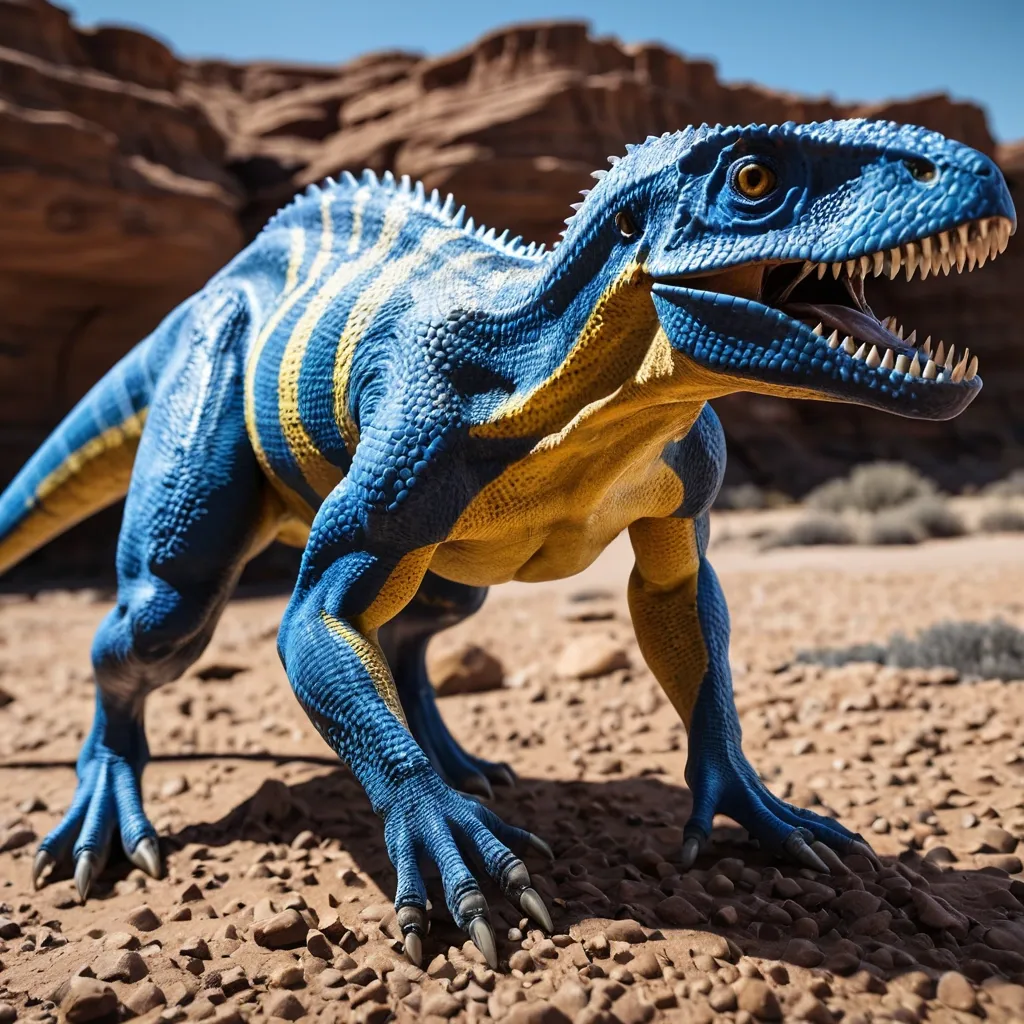
The hybrid was created by modifying the genome of a Tyrannosaurus rex , with the DNA of three other theropod species that were Utahraptor , Saurophaganax , and Giganotosaurus. Also the DNA of Quadrupes like Triceratops , and Scelidosaurus. DNA of modern animals such as Greater blue-ringed octopus , Inland Taipan , Northern Short-tailed Shrew , Komodo Dragon , Opossum , Mongoose , Gigantopithecus , Whiptail Lizard , Cuttlefish , and Tardigrades. The genome of Tyrannosaurus rex , Triceratops and Giganotosaurus was used as the base genome for the hybrid. Including the shape of the head in some parts from Giganotosaurus and Triceratops. Utahraptor DNA was added for high levels of intelligence and the ability to make plans , decisions and pack hunting. Reduced hind legs and Ape DNA added Knuckle-walking Quadruped. Triceratops , and Scelidosaurus were added to act as a biological form of armor that absorbed most of the incoming attacks. Northern short-tailed shrew , the Inland taipan's retractable fangs and the Komodo Dragon DNA was used to form the teeth of the Indominus that were used to tear through the flesh and armor of opponents. Saurophaganax and Gigantopithecus DNA added the presence of long strong arms with slashing hook claws and the use of tools. A swipe of the hybrid's claws would take down bigger opponents. While using tools for smaller elusive prey. Cuttlefish genes were intended to help the Venenosus withstand an accelerated growth , but it also added chromatophore cells in the skin so it could change the shape , color , and texture of its skin like a cuttlefish. Opossum , Mongoose and Tardigrades DNA was added for the Venenosus to be more resistant to climate changes , harmful toxins or bacterial infections , while tardigrades also added survival of extreme conditions such as exposure to extreme temperatures , extreme pressures , air deprivation , radiation , dehydration , and starvation. They have several defense mechanisms , including: A metabolic rate that gets as low as 0.01 percent of the normal rate. Organs protected by a sugary gel called trehalose. A protein that shields their DNA from radiation harm. Synthesis of cryoprotectant in chilly temperatures to prevent the development of ice crystals.Northern short-tailed shrew , the Inland Taipan , Greater blue-ringed octopus and the Komodo Dragon's DNA also added special cavities and glands in the skull that gave her infrared vision , and highly toxic saliva. Said DNA also gave her the ability to open her mandibles and jaws as wide as a snake , specifically at around 90 degrees.Lastly , DNA from a whiptail lizard was added for reproduction purposes. ,
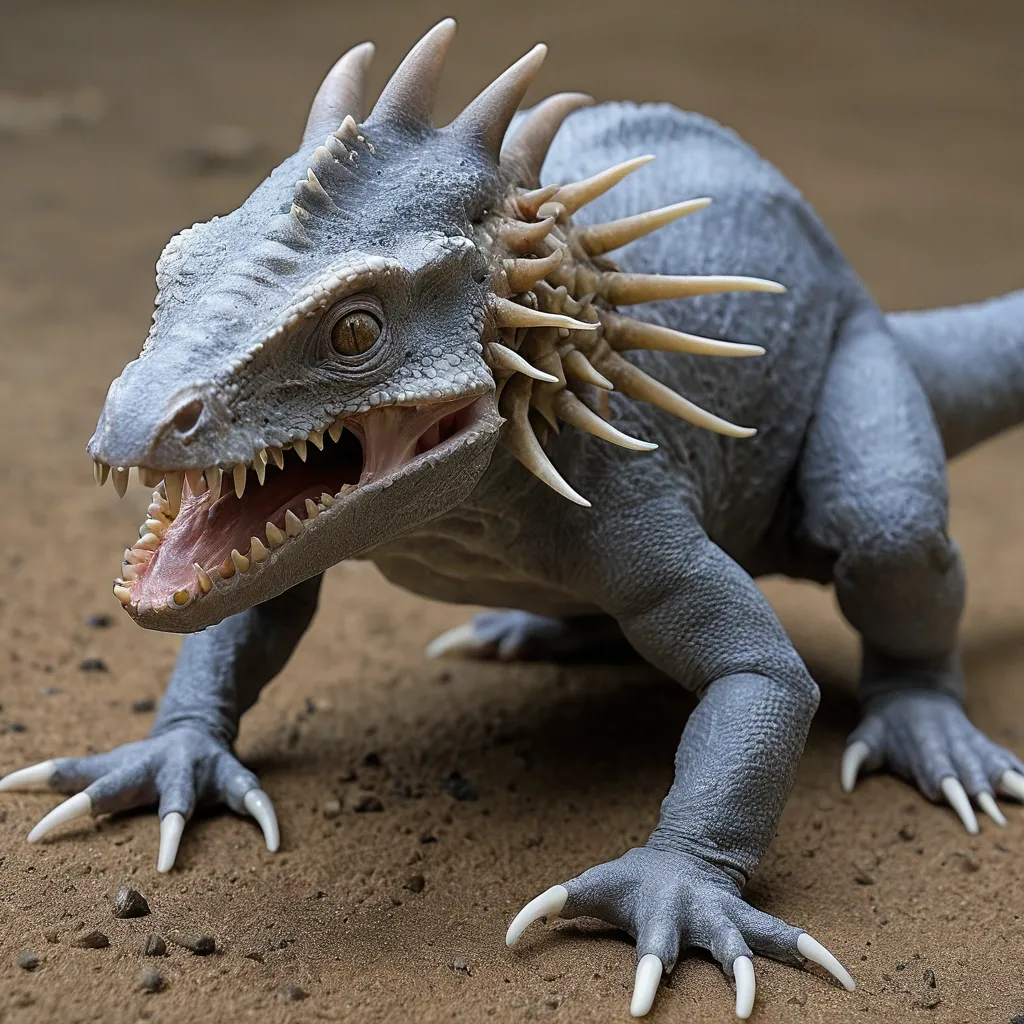
The genome of Tyrannosaurus rex , Triceratops and Giganotosaurus was used as the base genome for the hybrid. Including the shape of the head in some parts from Triceratops. Utahraptor DNA was added for high levels of intelligence and the ability to make plans , decisions and pack hunting. Reduced hind legs and Ape DNA added Knuckle-walking Quadruped. Triceratops , and Scelidosaurus were added to act as a biological form of armor that absorbed most of the incoming attacks. Northern short-tailed shrew , the Inland taipan's retractable fangs and the Komodo Dragon DNA was used to form the teeth of the Indominus that were used to tear through the flesh and armor of opponents. Saurophaganax and Gigantopithecus DNA added the presence of long strong arms with slashing hook claws and the use of tools. A swipe of the hybrid's claws would take down bigger opponents. While using tools for smaller elusive prey. Cuttlefish genes were intended to help the Venenosus withstand an accelerated growth , but it also added chromatophore cells in the skin so it could change the shape , color , and texture of its skin like a cuttlefish. Opossum , Mongoose and Tardigrades DNA was added for the Venenosus to be more resistant to climate changes , harmful toxins or bacterial infections , while tardigrades also added survival of extreme conditions such as exposure to extreme temperatures , extreme pressures , air deprivation , radiation , dehydration , and starvation. They have several defense mechanisms , including: A metabolic rate that gets as low as 0.01 percent of the normal rate. Organs protected by a sugary gel called trehalose. A protein that shields their DNA from radiation harm. Synthesis of cryoprotectant in chilly temperatures to prevent the development of ice crystals.Northern short-tailed shrew , the Inland Taipan , Greater blue-ringed octopus and the Komodo Dragon's DNA also added special cavities and glands in the skull that gave her infrared vision , and highly toxic saliva. Said DNA also gave her the ability to open her mandibles and jaws as wide as a snake , specifically at around 90 degrees.Lastly , DNA from a whiptail lizard was added for reproduction purposes. ,
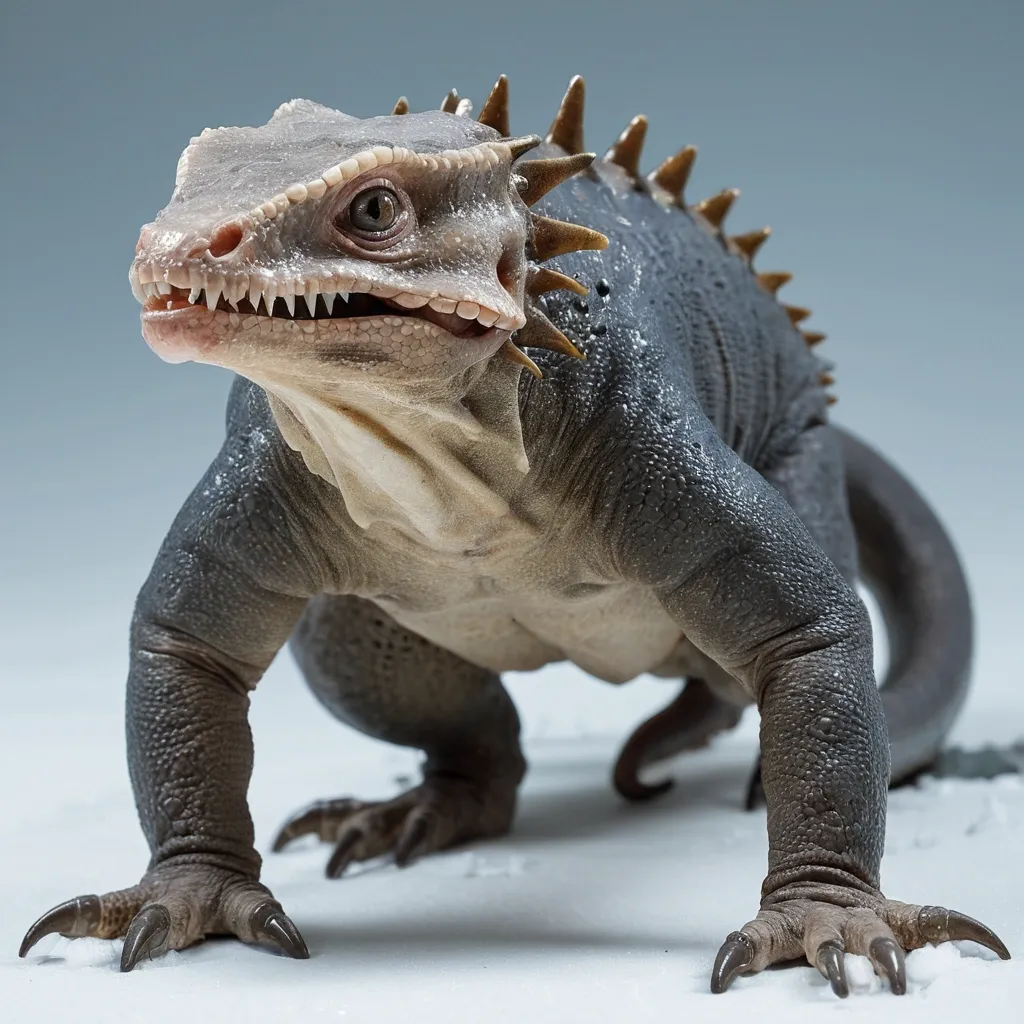
The genome of Tyrannosaurus rex , Triceratops and Giganotosaurus was used as the base genome for the hybrid. Including the shape of the head in some parts from Triceratops. Utahraptor DNA was added for high levels of intelligence and the ability to make plans , decisions and pack hunting. Reduced hind legs and Ape DNA added Knuckle-walking Quadruped. Triceratops , and Scelidosaurus were added to act as a biological form of armor that absorbed most of the incoming attacks. Northern short-tailed shrew , the Inland taipan's retractable fangs and the Komodo Dragon DNA was used to form the teeth of the Indominus that were used to tear through the flesh and armor of opponents. Saurophaganax and Gigantopithecus DNA added the presence of long strong arms with slashing hook claws and the use of tools. A swipe of the hybrid's claws would take down bigger opponents. While using tools for smaller elusive prey. Cuttlefish genes were intended to help the Venenosus withstand an accelerated growth , but it also added chromatophore cells in the skin so it could change the shape , color , and texture of its skin like a cuttlefish. Opossum , Mongoose and Tardigrades DNA was added for the Venenosus to be more resistant to climate changes , harmful toxins or bacterial infections , while tardigrades also added survival of extreme conditions such as exposure to extreme temperatures , extreme pressures , air deprivation , radiation , dehydration , and starvation. They have several defense mechanisms , including: A metabolic rate that gets as low as 0.01 percent of the normal rate. Organs protected by a sugary gel called trehalose. A protein that shields their DNA from radiation harm. Synthesis of cryoprotectant in chilly temperatures to prevent the development of ice crystals.Northern short-tailed shrew , the Inland Taipan , Greater blue-ringed octopus and the Komodo Dragon's DNA also added special cavities and glands in the skull that gave her infrared vision , and highly toxic saliva. Said DNA also gave her the ability to open her mandibles and jaws as wide as a snake , specifically at around 90 degrees.Lastly , DNA from a whiptail lizard was added for reproduction purposes. ,
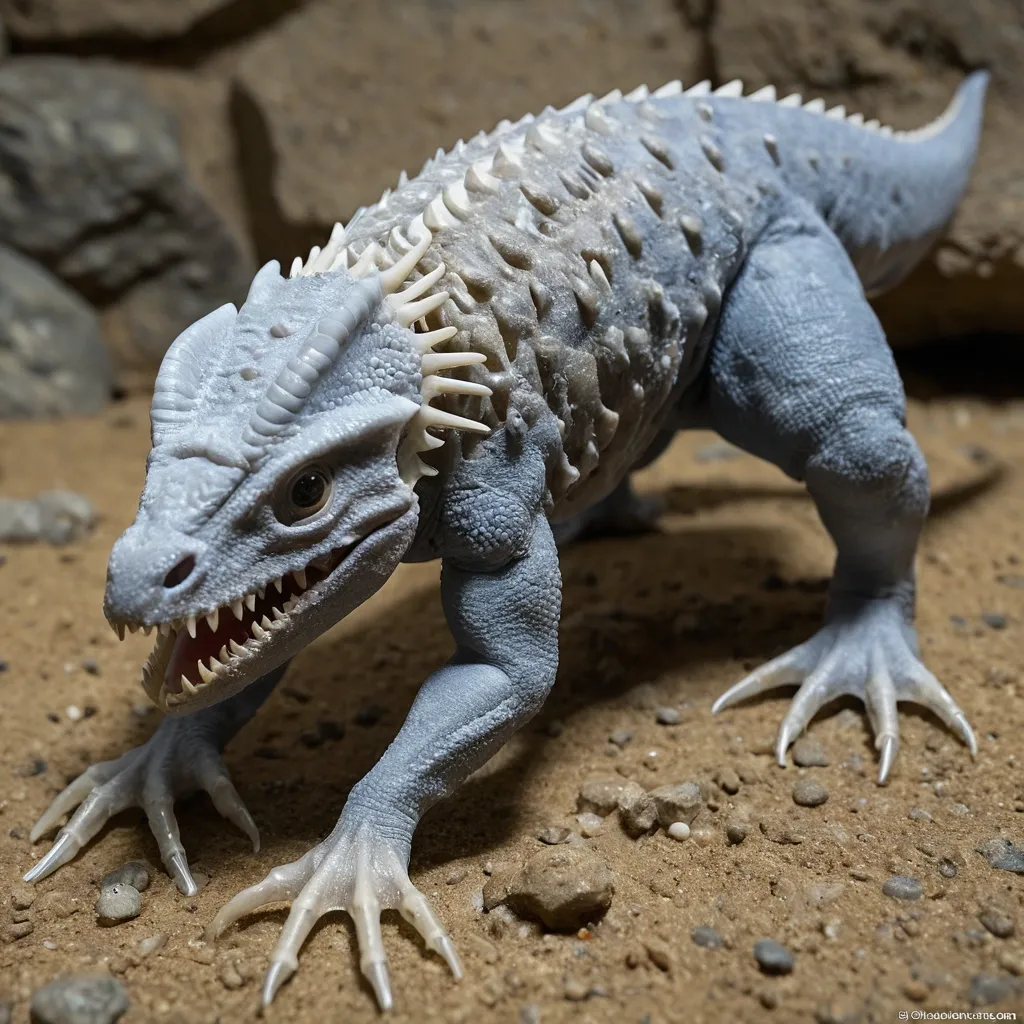
The genome of Tyrannosaurus rex , Triceratops and Giganotosaurus was used as the base genome for the hybrid. Including the shape of the head in some parts from Triceratops. Utahraptor DNA was added for high levels of intelligence and the ability to make plans , decisions and pack hunting. Reduced hind legs and Ape DNA added Knuckle-walking Quadruped. Triceratops , and Scelidosaurus were added to act as a biological form of armor that absorbed most of the incoming attacks. Northern short-tailed shrew , the Inland taipan's retractable fangs and the Komodo Dragon DNA was used to form the teeth of the Indominus that were used to tear through the flesh and armor of opponents. Saurophaganax and Gigantopithecus DNA added the presence of long strong arms with slashing hook claws and the use of tools. A swipe of the hybrid's claws would take down bigger opponents. While using tools for smaller elusive prey. Cuttlefish genes were intended to help the Venenosus withstand an accelerated growth , but it also added chromatophore cells in the skin so it could change the shape , color , and texture of its skin like a cuttlefish. Opossum , Mongoose and Tardigrades DNA was added for the Venenosus to be more resistant to climate changes , harmful toxins or bacterial infections , while tardigrades also added survival of extreme conditions such as exposure to extreme temperatures , extreme pressures , air deprivation , radiation , dehydration , and starvation. They have several defense mechanisms , including: A metabolic rate that gets as low as 0.01 percent of the normal rate. Organs protected by a sugary gel called trehalose. A protein that shields their DNA from radiation harm. Synthesis of cryoprotectant in chilly temperatures to prevent the development of ice crystals.Northern short-tailed shrew , the Inland Taipan , Greater blue-ringed octopus and the Komodo Dragon's DNA also added special cavities and glands in the skull that gave her infrared vision , and highly toxic saliva. Said DNA also gave her the ability to open her mandibles and jaws as wide as a snake , specifically at around 90 degrees.Lastly , DNA from a whiptail lizard was added for reproduction purposes. ,
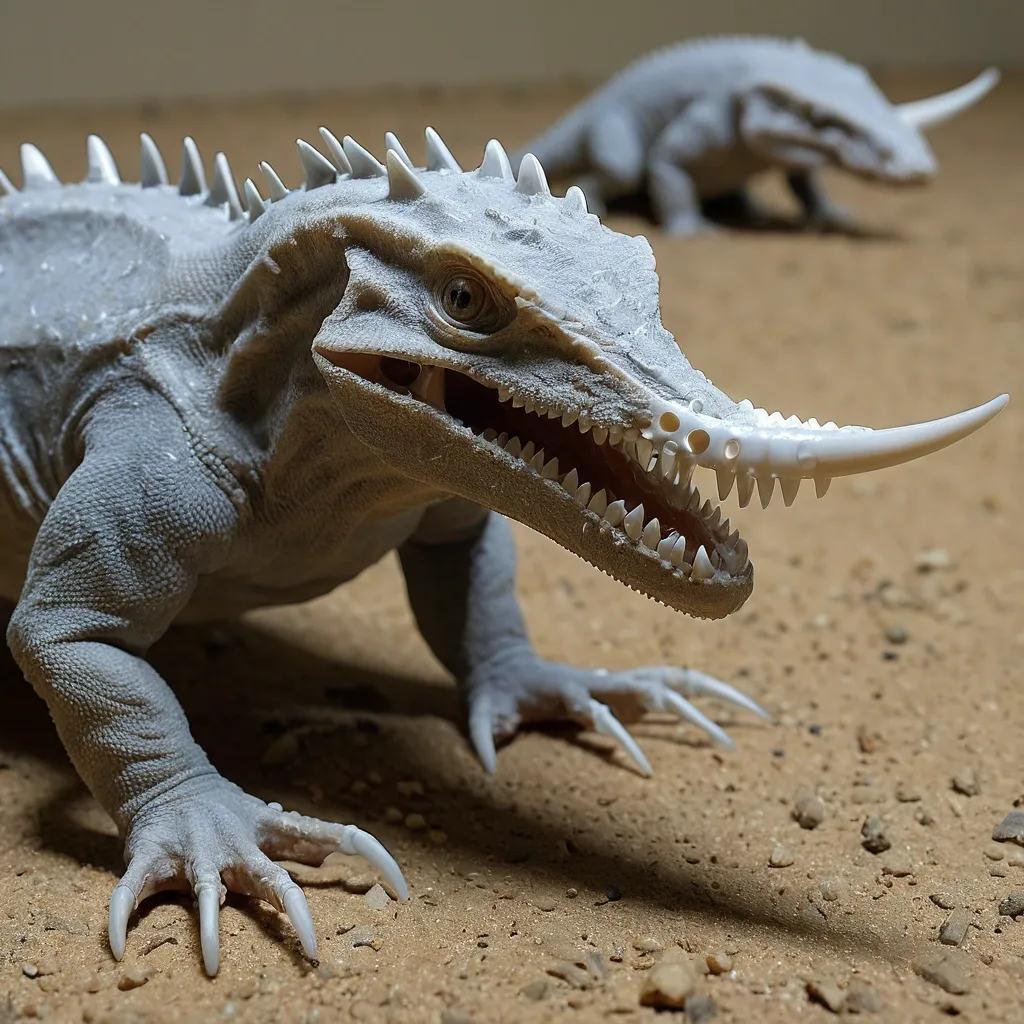
The genome of Tyrannosaurus rex , Triceratops and Giganotosaurus was used as the base genome for the hybrid. Including the shape of the head in some parts from Triceratops. Utahraptor DNA was added for high levels of intelligence and the ability to make plans , decisions and pack hunting. Reduced hind legs and Ape DNA added Knuckle-walking Quadruped. Triceratops , and Scelidosaurus were added to act as a biological form of armor that absorbed most of the incoming attacks. Northern short-tailed shrew , the Inland taipan's retractable fangs and the Komodo Dragon DNA was used to form the teeth of the Indominus that were used to tear through the flesh and armor of opponents. Saurophaganax and Gigantopithecus DNA added the presence of long strong arms with slashing hook claws and the use of tools. A swipe of the hybrid's claws would take down bigger opponents. While using tools for smaller elusive prey. Cuttlefish genes were intended to help the Venenosus withstand an accelerated growth , but it also added chromatophore cells in the skin so it could change the shape , color , and texture of its skin like a cuttlefish. Opossum , Mongoose and Tardigrades DNA was added for the Venenosus to be more resistant to climate changes , harmful toxins or bacterial infections , while tardigrades also added survival of extreme conditions such as exposure to extreme temperatures , extreme pressures , air deprivation , radiation , dehydration , and starvation. They have several defense mechanisms , including: A metabolic rate that gets as low as 0.01 percent of the normal rate. Organs protected by a sugary gel called trehalose. A protein that shields their DNA from radiation harm. Synthesis of cryoprotectant in chilly temperatures to prevent the development of ice crystals.Northern short-tailed shrew , the Inland Taipan , Greater blue-ringed octopus and the Komodo Dragon's DNA also added special cavities and glands in the skull that gave her infrared vision , and highly toxic saliva. Said DNA also gave her the ability to open her mandibles and jaws as wide as a snake , specifically at around 90 degrees.Lastly , DNA from a whiptail lizard was added for reproduction purposes. ,
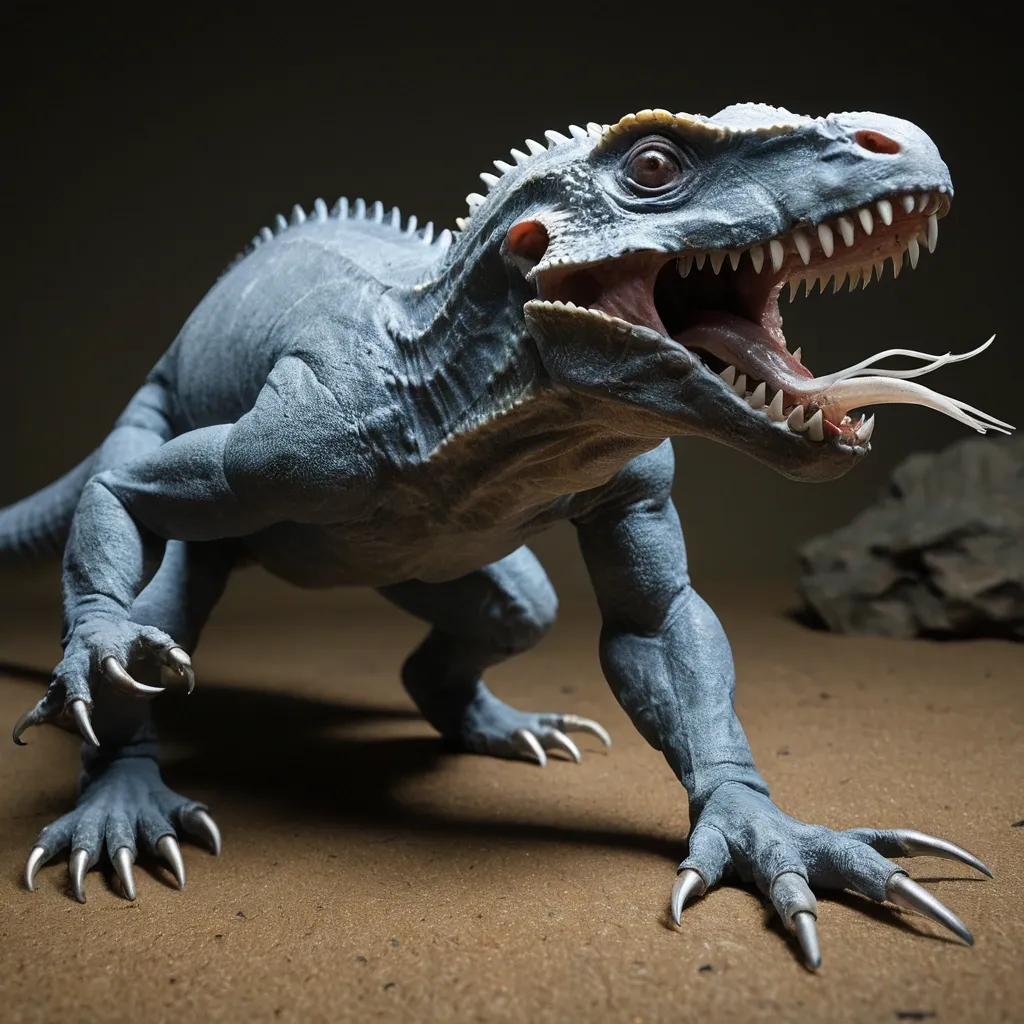
The genome of Tyrannosaurus rex , Triceratops and Giganotosaurus was used as the base genome for the hybrid. Including the shape of the head in some parts from Giganotosaurus and Triceratops. It also gave the Indominus rex an incredibly strong bite that could crush bulletproof glass. Utahraptor DNA was added for high levels of intelligence and the ability to make plans , decisions and pack hunting. Reduced hind legs and Ape DNA added Knuckle-walking Quadruped. Triceratops , and Scelidosaurus were added to act as a biological form of armor that absorbed most of the incoming attacks. Northern short-tailed shrew , the Inland taipan's retractable fangs and the Komodo Dragon DNA was used to form the teeth of the Indominus that were used to tear through the flesh and armor of opponents. Saurophaganax and Gigantopithecus DNA added the presence of long strong arms with slashing hook claws and the use of tools. A swipe of the hybrid's claws would take down bigger opponents. While using tools for smaller elusive prey. Cuttlefish genes were intended to help the Venenosus withstand an accelerated growth , but it also added chromatophore cells in the skin so it could change the shape , color , and texture of its skin like a cuttlefish. Opossum , Mongoose and Tardigrades DNA was added for the Venenosus to be more resistant to climate changes , harmful toxins or bacterial infections , while tardigrades also added survival of extreme conditions such as exposure to extreme temperatures , extreme pressures , air deprivation , radiation , dehydration , and starvation. They have several defense mechanisms , including: A metabolic rate that gets as low as 0.01 percent of the normal rate. Organs protected by a sugary gel called trehalose. A protein that shields their DNA from radiation harm. Synthesis of cryoprotectant in chilly temperatures to prevent the development of ice crystals.Northern short-tailed shrew , the Inland Taipan , Greater blue-ringed octopus and the Komodo Dragon's DNA also added special cavities and glands in the skull that gave her infrared vision , and highly toxic saliva. Said DNA also gave her the ability to open her mandibles and jaws as wide as a snake , specifically at around 90 degrees.Lastly , DNA from a whiptail lizard was added for reproduction purposes. ,
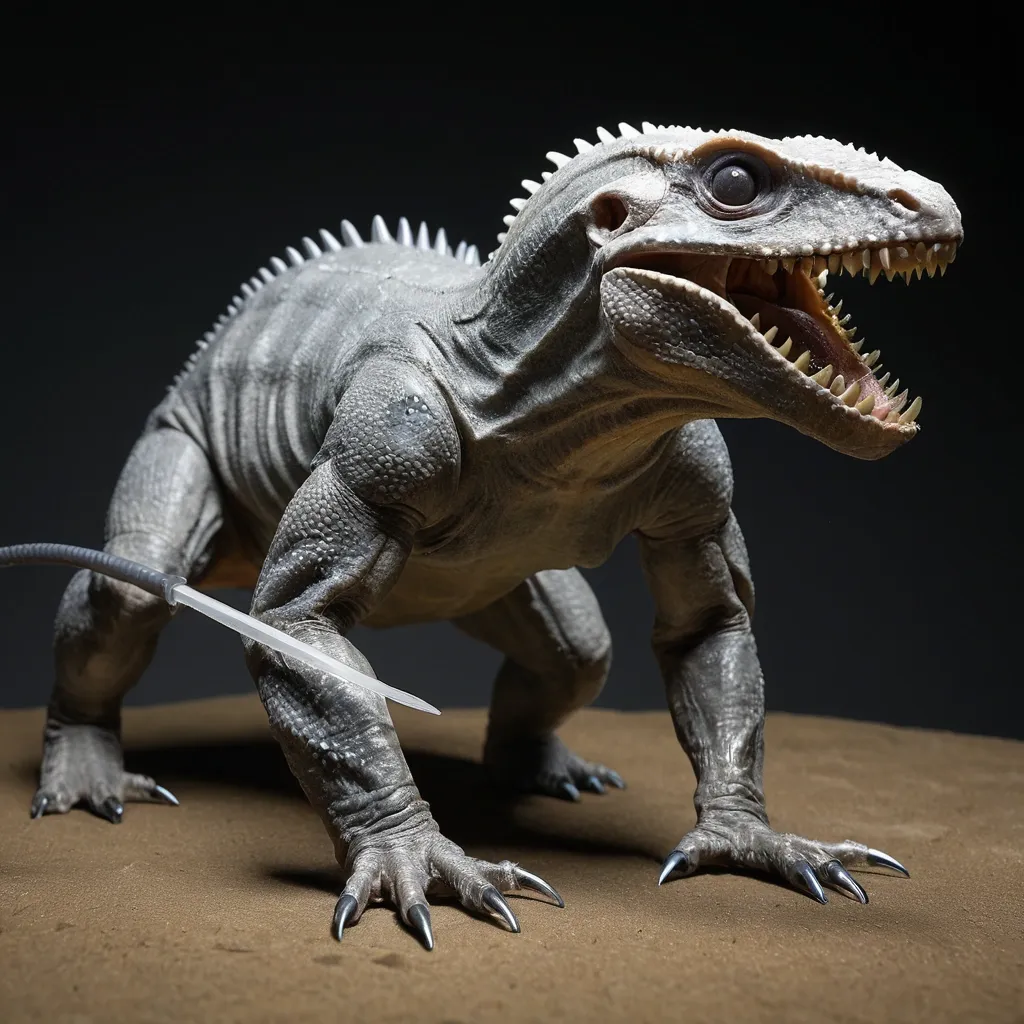
The genome of Tyrannosaurus rex , Triceratops and Giganotosaurus was used as the base genome for the hybrid. Including the shape of the head in some parts from Giganotosaurus and Triceratops. It also gave the Indominus rex an incredibly strong bite that could crush bulletproof glass. Utahraptor DNA was added for high levels of intelligence and the ability to make plans , decisions and pack hunting. Reduced hind legs and Ape DNA added Knuckle-walking Quadruped. Triceratops , and Scelidosaurus were added to act as a biological form of armor that absorbed most of the incoming attacks. Northern short-tailed shrew , the Inland taipan's retractable fangs and the Komodo Dragon DNA was used to form the teeth of the Indominus that were used to tear through the flesh and armor of opponents. Saurophaganax and Gigantopithecus DNA added the presence of long strong arms with slashing hook claws and the use of tools. A swipe of the hybrid's claws would take down bigger opponents. While using tools for smaller elusive prey. Cuttlefish genes were intended to help the Venenosus withstand an accelerated growth , but it also added chromatophore cells in the skin so it could change the shape , color , and texture of its skin like a cuttlefish. Opossum , Mongoose and Tardigrades DNA was added for the Venenosus to be more resistant to climate changes , harmful toxins or bacterial infections , while tardigrades also added survival of extreme conditions such as exposure to extreme temperatures , extreme pressures , air deprivation , radiation , dehydration , and starvation. They have several defense mechanisms , including: A metabolic rate that gets as low as 0.01 percent of the normal rate. Organs protected by a sugary gel called trehalose. A protein that shields their DNA from radiation harm. Synthesis of cryoprotectant in chilly temperatures to prevent the development of ice crystals.Northern short-tailed shrew , the Inland Taipan , Greater blue-ringed octopus and the Komodo Dragon's DNA also added special cavities and glands in the skull that gave her infrared vision , and highly toxic saliva. Said DNA also gave her the ability to open her mandibles and jaws as wide as a snake , specifically at around 90 degrees.Lastly , DNA from a whiptail lizard was added for reproduction purposes. ,
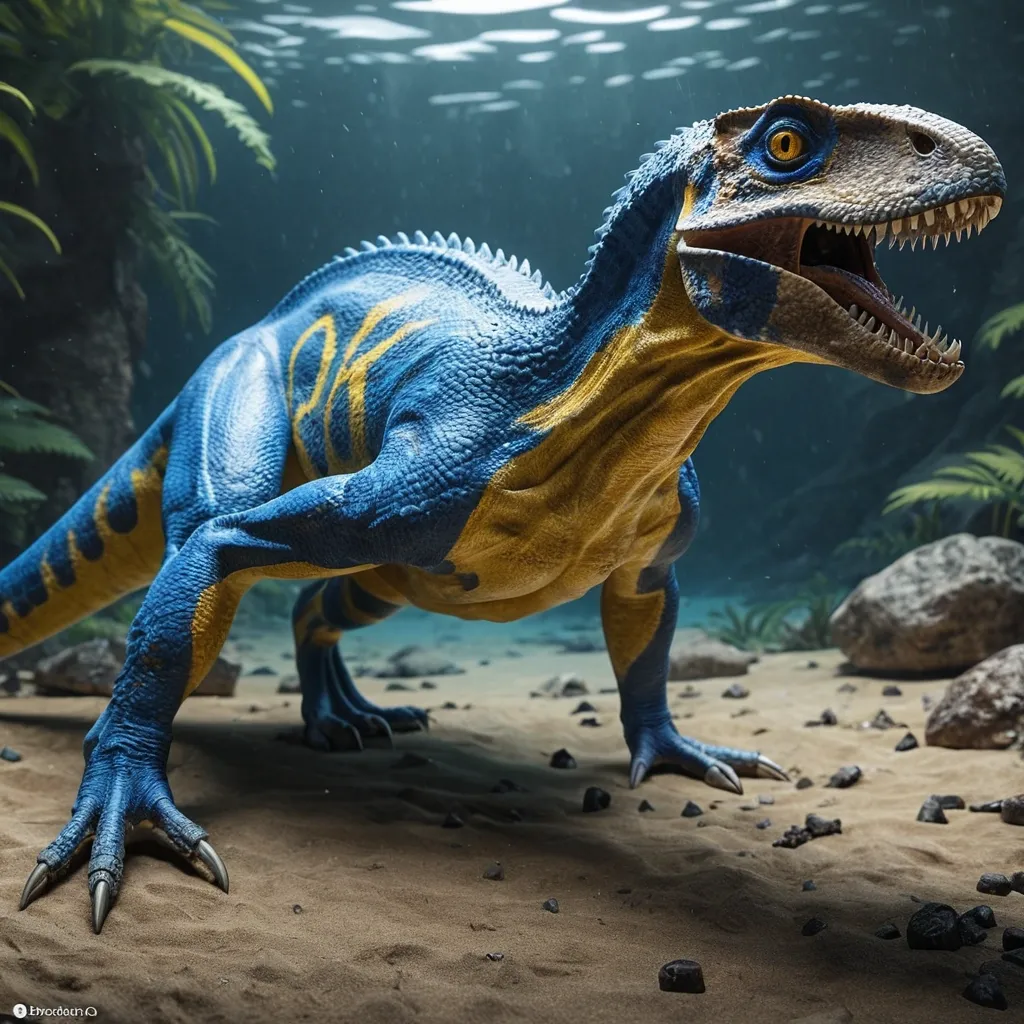
The hybrid was created by modifying the genome of a Tyrannosaurus rex , with the DNA of three other theropod species that were Utahraptor , Saurophaganax , and Giganotosaurus. Also the DNA of Quadrupes like Triceratops , and Scelidosaurus. DNA of modern animals such as Greater blue-ringed octopus , Inland Taipan , Northern Short-tailed Shrew , Komodo Dragon , Opossum , Mongoose , Gigantopithecus , Whiptail Lizard , Cuttlefish , and Tardigrades. The genome of Tyrannosaurus rex , Triceratops and Giganotosaurus was used as the base genome for the hybrid. Including the shape of the head in some parts from Giganotosaurus and Triceratops. It also gave the Indominus rex an incredibly strong bite that could crush bulletproof glass. Utahraptor DNA was added for high levels of intelligence and the ability to make plans , decisions and pack hunting. Reduced hind legs and Ape DNA added Knuckle-walking Quadruped. Triceratops , and Scelidosaurus were added to act as a biological form of armor that absorbed most of the incoming attacks. Northern short-tailed shrew , the Inland taipan's retractable fangs and the Komodo Dragon DNA was used to form the teeth of the Indominus that were used to tear through the flesh and armor of opponents. Saurophaganax and Gigantopithecus DNA added the presence of long strong arms with slashing hook claws and the use of tools. A swipe of the hybrid's claws would take down bigger opponents. While using tools for smaller elusive prey. Cuttlefish genes were intended to help the Venenosus withstand an accelerated growth , but it also added chromatophore cells in the skin so it could change the shape , color , and texture of its skin like a cuttlefish. Opossum , Mongoose and Tardigrades DNA was added for the Venenosus to be more resistant to climate changes , harmful toxins or bacterial infections , while tardigrades also added survival of extreme conditions such as exposure to extreme temperatures , extreme pressures , air deprivation , radiation , dehydration , and starvation. They have several defense mechanisms , including: A metabolic rate that gets as low as 0.01 percent of the normal rate. Organs protected by a sugary gel called trehalose. A protein that shields their DNA from radiation harm. Synthesis of cryoprotectant in chilly temperatures to prevent the development of ice crystals.Northern short-tailed shrew , the Inland Taipan , Greater blue-ringed octopus and the Komodo Dragon's DNA also added special cavities and glands in the skull that gave her infrared vision , and highly toxic saliva. Said DNA also gave her the ability to open her mandibles and jaws as wide as a snake , specifically at around 90 degrees.Lastly , DNA from a whiptail lizard was added for reproduction purposes. ,
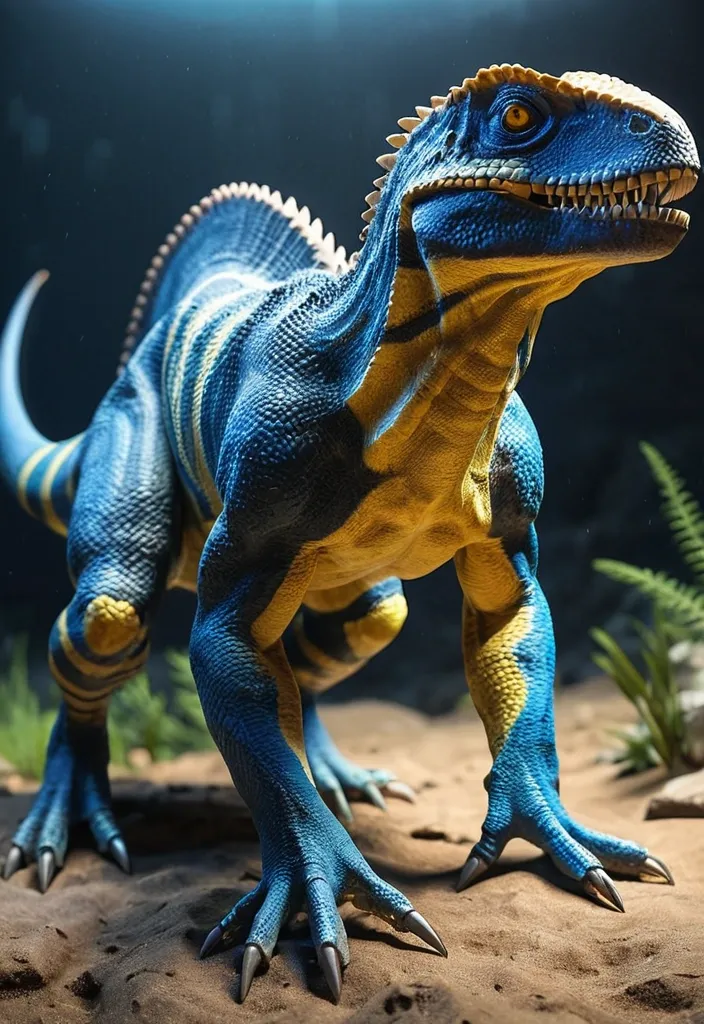
The hybrid was created by modifying the genome of a Tyrannosaurus rex , with the DNA of three other theropod species that were Utahraptor , Saurophaganax , and Giganotosaurus. Also the DNA of Quadrupes like Triceratops , and Scelidosaurus. DNA of modern animals such as Greater blue-ringed octopus , Inland Taipan , Northern Short-tailed Shrew , Komodo Dragon , Opossum , Mongoose , Gigantopithecus , Whiptail Lizard , Cuttlefish , and Tardigrades. The genome of Tyrannosaurus rex , Triceratops and Giganotosaurus was used as the base genome for the hybrid. Including the shape of the head in some parts from Giganotosaurus and Triceratops. It also gave the Indominus rex an incredibly strong bite that could crush bulletproof glass. Utahraptor DNA was added for high levels of intelligence and the ability to make plans , decisions and pack hunting. Reduced hind legs and Ape DNA added Knuckle-walking Quadruped. Triceratops , and Scelidosaurus were added to act as a biological form of armor that absorbed most of the incoming attacks. Northern short-tailed shrew , the Inland taipan's retractable fangs and the Komodo Dragon DNA was used to form the teeth of the Indominus that were used to tear through the flesh and armor of opponents. Saurophaganax and Gigantopithecus DNA added the presence of long strong arms with slashing hook claws and the use of tools. A swipe of the hybrid's claws would take down bigger opponents. While using tools for smaller elusive prey. Cuttlefish genes were intended to help the Venenosus withstand an accelerated growth , but it also added chromatophore cells in the skin so it could change the shape , color , and texture of its skin like a cuttlefish. Opossum , Mongoose and Tardigrades DNA was added for the Venenosus to be more resistant to climate changes , harmful toxins or bacterial infections , while tardigrades also added survival of extreme conditions such as exposure to extreme temperatures , extreme pressures , air deprivation , radiation , dehydration , and starvation. They have several defense mechanisms , including: A metabolic rate that gets as low as 0.01 percent of the normal rate. Organs protected by a sugary gel called trehalose. A protein that shields their DNA from radiation harm. Synthesis of cryoprotectant in chilly temperatures to prevent the development of ice crystals.Northern short-tailed shrew , the Inland Taipan , Greater blue-ringed octopus and the Komodo Dragon's DNA also added special cavities and glands in the skull that gave her infrared vision , and highly toxic saliva. Said DNA also gave her the ability to open her mandibles and jaws as wide as a snake , specifically at around 90 degrees.Lastly , DNA from a whiptail lizard was added for reproduction purposes. ,
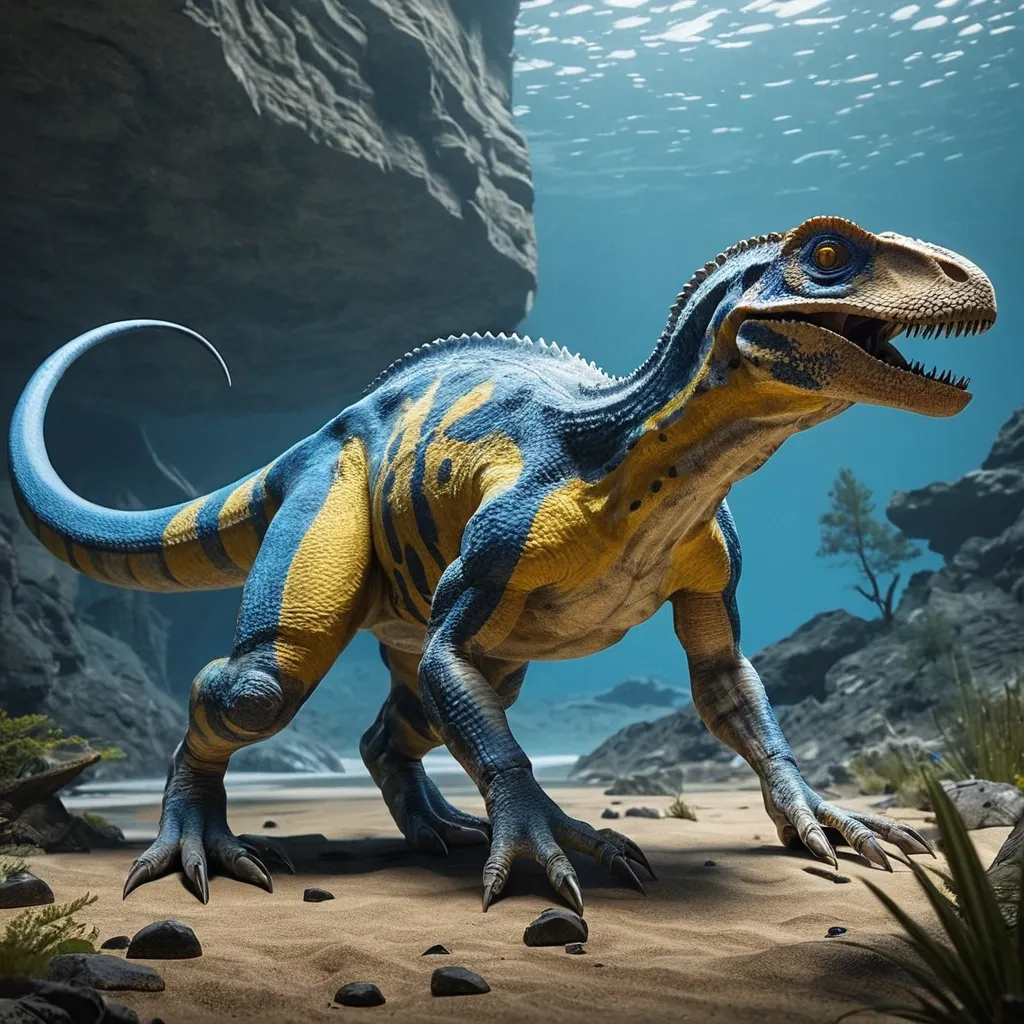
The hybrid was created by modifying the genome of a Tyrannosaurus rex , with the DNA of three other theropod species that were Utahraptor , Saurophaganax , and Giganotosaurus. Also the DNA of Quadrupes like Triceratops , and Scelidosaurus. DNA of modern animals such as Greater blue-ringed octopus , Inland Taipan , Northern Short-tailed Shrew , Komodo Dragon , Opossum , Mongoose , Gigantopithecus , Whiptail Lizard , Cuttlefish , and Tardigrades. The genome of Tyrannosaurus rex , Triceratops and Giganotosaurus was used as the base genome for the hybrid. Including the shape of the head in some parts from Giganotosaurus and Triceratops. It also gave the Indominus rex an incredibly strong bite that could crush bulletproof glass. Utahraptor DNA was added for high levels of intelligence and the ability to make plans , decisions and pack hunting. Reduced hind legs and Ape DNA added Knuckle-walking Quadruped. Triceratops , and Scelidosaurus were added to act as a biological form of armor that absorbed most of the incoming attacks. Northern short-tailed shrew , the Inland taipan's retractable fangs and the Komodo Dragon DNA was used to form the teeth of the Indominus that were used to tear through the flesh and armor of opponents. Saurophaganax and Gigantopithecus DNA added the presence of long strong arms with slashing hook claws and the use of tools. A swipe of the hybrid's claws would take down bigger opponents. While using tools for smaller elusive prey. Cuttlefish genes were intended to help the Venenosus withstand an accelerated growth , but it also added chromatophore cells in the skin so it could change the shape , color , and texture of its skin like a cuttlefish. Opossum , Mongoose and Tardigrades DNA was added for the Venenosus to be more resistant to climate changes , harmful toxins or bacterial infections , while tardigrades also added survival of extreme conditions such as exposure to extreme temperatures , extreme pressures , air deprivation , radiation , dehydration , and starvation. They have several defense mechanisms , including: A metabolic rate that gets as low as 0.01 percent of the normal rate. Organs protected by a sugary gel called trehalose. A protein that shields their DNA from radiation harm. Synthesis of cryoprotectant in chilly temperatures to prevent the development of ice crystals.Northern short-tailed shrew , the Inland Taipan , Greater blue-ringed octopus and the Komodo Dragon's DNA also added special cavities and glands in the skull that gave her infrared vision , and highly toxic saliva. Said DNA also gave her the ability to open her mandibles and jaws as wide as a snake , specifically at around 90 degrees.Lastly , DNA from a whiptail lizard was added for reproduction purposes. ,
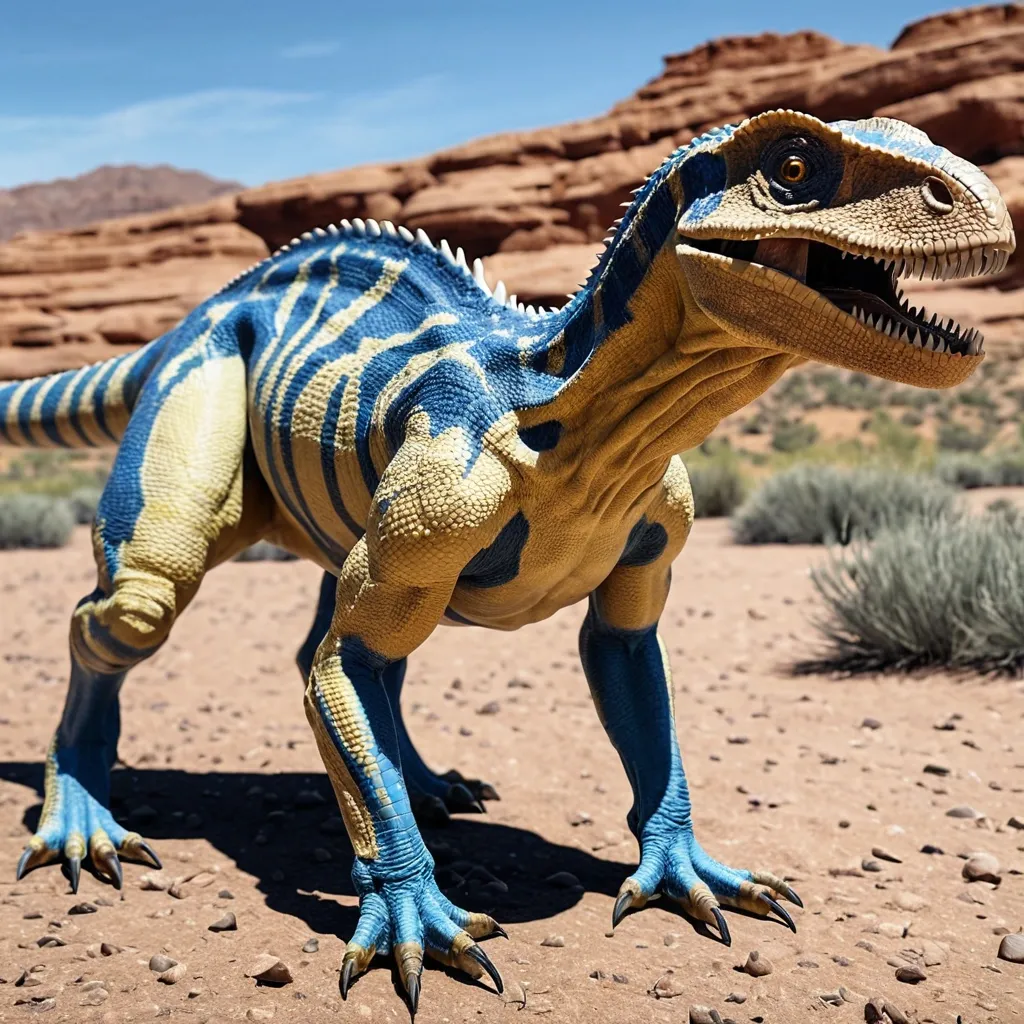
The hybrid was created by modifying the genome of a Tyrannosaurus rex , with the DNA of three other theropod species that were Utahraptor , Saurophaganax , and Giganotosaurus. Also the DNA of Quadrupes like Triceratops , and Scelidosaurus. DNA of modern animals such as Greater blue-ringed octopus , Inland Taipan , Northern Short-tailed Shrew , Komodo Dragon , Opossum , Mongoose , Gigantopithecus , Whiptail Lizard , Cuttlefish , and Tardigrades. The genome of Tyrannosaurus rex , Triceratops and Giganotosaurus was used as the base genome for the hybrid. Including the shape of the head in some parts from Giganotosaurus and Triceratops. It also gave the Indominus rex an incredibly strong bite that could crush bulletproof glass. Utahraptor DNA was added for high levels of intelligence and the ability to make plans , decisions and pack hunting. Reduced hind legs and Ape DNA added Knuckle-walking Quadruped. Triceratops , and Scelidosaurus were added to act as a biological form of armor that absorbed most of the incoming attacks. Northern short-tailed shrew , the Inland taipan's retractable fangs and the Komodo Dragon DNA was used to form the teeth of the Indominus that were used to tear through the flesh and armor of opponents. Saurophaganax and Gigantopithecus DNA added the presence of long strong arms with slashing hook claws and the use of tools. A swipe of the hybrid's claws would take down bigger opponents. While using tools for smaller elusive prey. Cuttlefish genes were intended to help the Venenosus withstand an accelerated growth , but it also added chromatophore cells in the skin so it could change the shape , color , and texture of its skin like a cuttlefish. Opossum , Mongoose and Tardigrades DNA was added for the Venenosus to be more resistant to climate changes , harmful toxins or bacterial infections , while tardigrades also added survival of extreme conditions such as exposure to extreme temperatures , extreme pressures , air deprivation , radiation , dehydration , and starvation. They have several defense mechanisms , including: A metabolic rate that gets as low as 0.01 percent of the normal rate. Organs protected by a sugary gel called trehalose. A protein that shields their DNA from radiation harm. Synthesis of cryoprotectant in chilly temperatures to prevent the development of ice crystals.Northern short-tailed shrew , the Inland Taipan , Greater blue-ringed octopus and the Komodo Dragon's DNA also added special cavities and glands in the skull that gave her infrared vision , and highly toxic saliva. Said DNA also gave her the ability to open her mandibles and jaws as wide as a snake , specifically at around 90 degrees.Lastly , DNA from a whiptail lizard was added for reproduction purposes. ,

